After the visit to the tomb of Tutankhamun, I started with my visits to three other tombs that were covered by my entrance ticket.
The first one was the tomb of Pharaoh Merenptah (ruled from 1213 to 1203 BCE) who belonged to the 19th dynasty of Ancient Egypt. It was precisely him who succeeded Ramesses II who was his father.
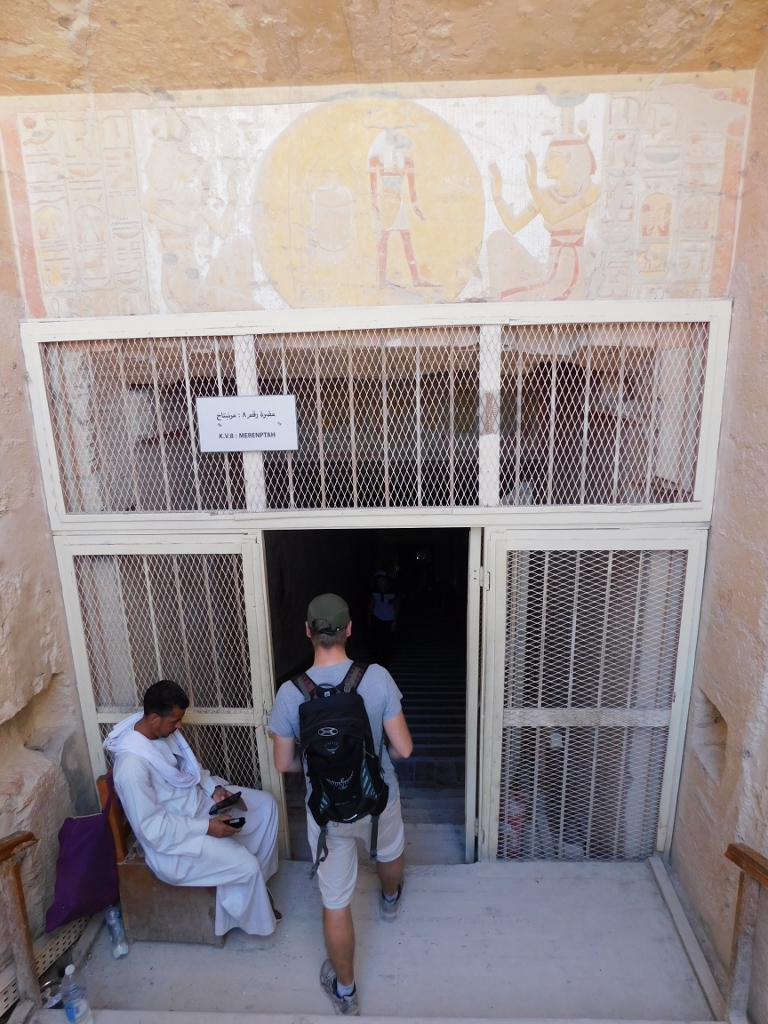 Entrance to the tomb of Pharaoh Merenptah
Entrance to the tomb of Pharaoh Merenptah
As soon as one enters the tomb, on the left-hand side, there is a nice relief with the depiction of the pharaoh addressing god Ra-Horakhty. Practically, in this aspect, the deity is a merger between gods Ra and Horus. God Ra was the god of the Sun, order, kings and the sky, while god Horus was also the god of the Sun. This is how things were among Ancient Egyptians. They must have known who was in charge of what. In any case, I have already mentioned before that different gods were depicted as human figures with a falcon head, but on the basis of the crown it is possible to conclude clearly who this is exactly. If you look a little more closely, you can see that the god here wears a sun-disc inside a cobra.
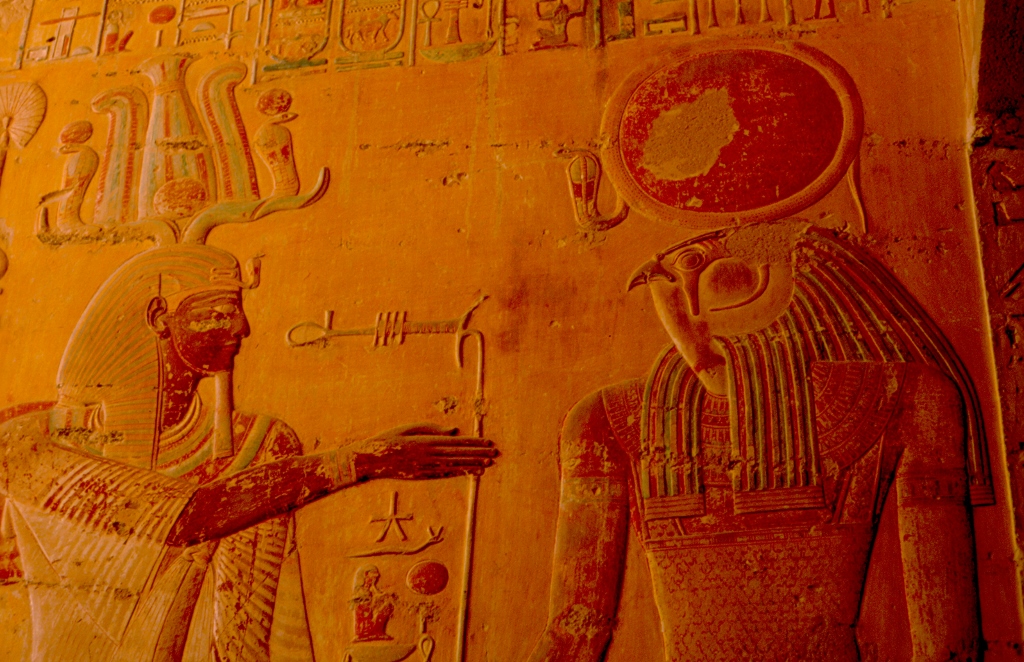 Pharaoh Merenptah is addressing god Ra-Horakhty (photo taken in 2001)
Pharaoh Merenptah is addressing god Ra-Horakhty (photo taken in 2001)
Then, along a wooden staircase, one descends to the bottom of the tomb. The entire tomb was done as a long hallway that goes down with extensions in a couple of places, as well as niches in the walls along the hallway.
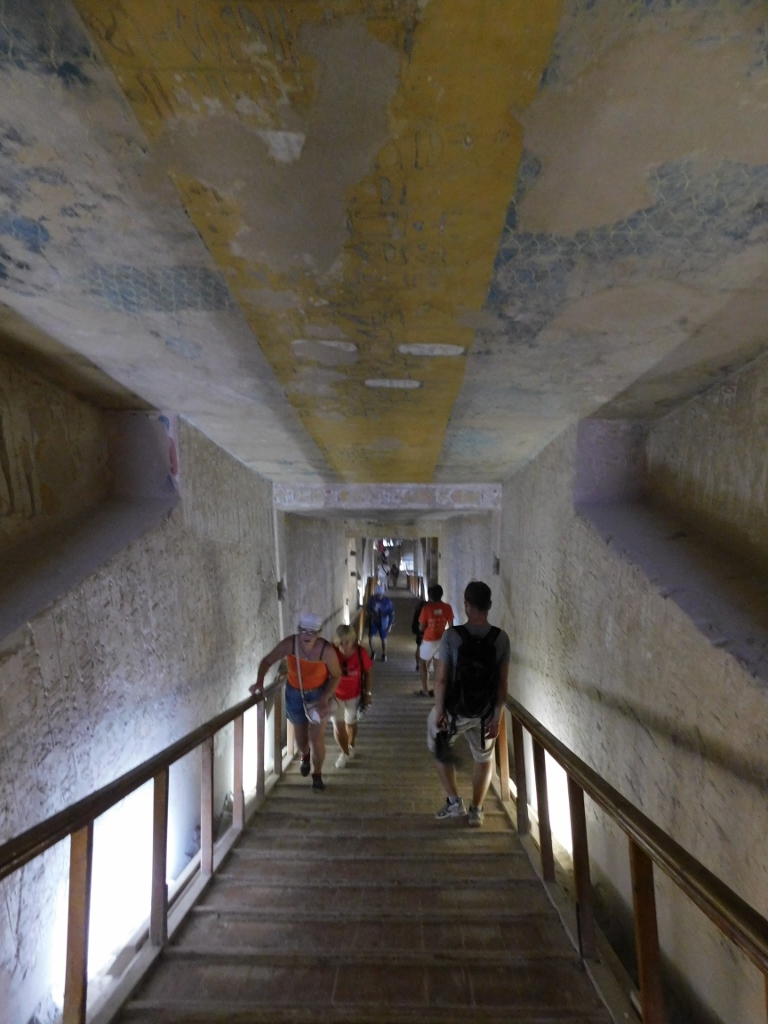 Tomb of Pharaoh Merenptah, a detail
Tomb of Pharaoh Merenptah, a detail
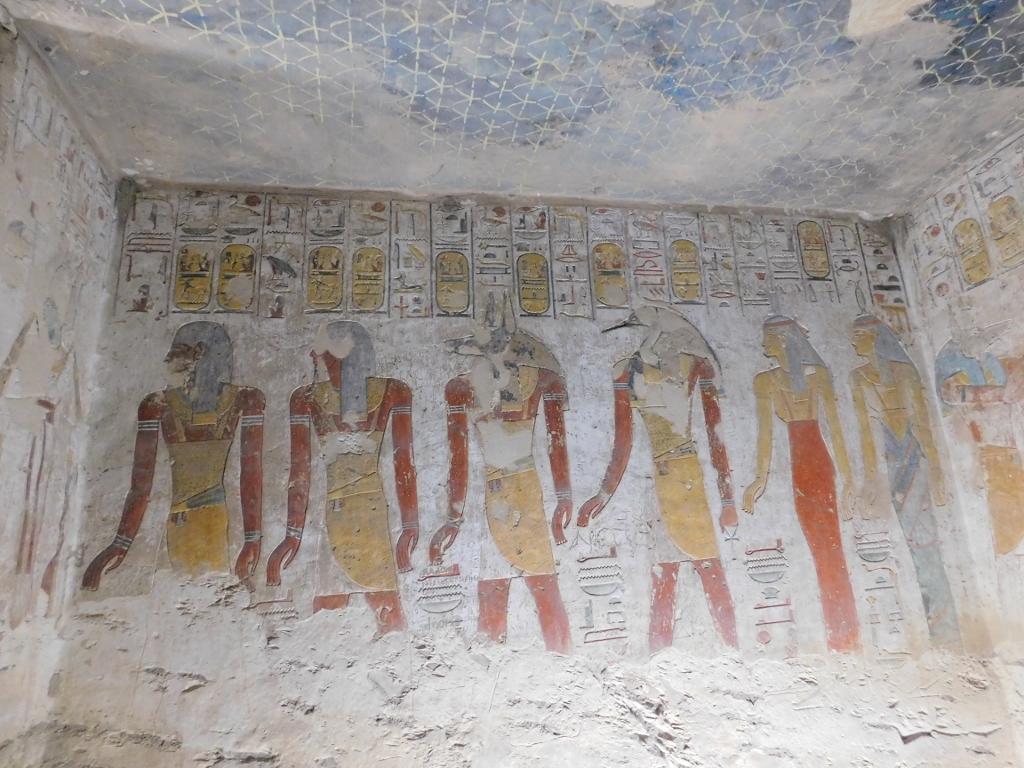 Tomb of Pharaoh Merenptah, a detail: in the middle there are gods Anubis and Thoth (the first one with canine head and the other with the head of an ibis)
Tomb of Pharaoh Merenptah, a detail: in the middle there are gods Anubis and Thoth (the first one with canine head and the other with the head of an ibis)
By the way, let me say that Anubis was the god of death, underworld, mummification and afterlife, and he is, quite logically, regularly depicted in the tombs.
Thoth, on the other hand, was the inventor of numbers and letters, he was the god of wisdom, writing, science, magic and art, and he was also the messenger of gods, so that he is also seen quite frequently in the tombs.
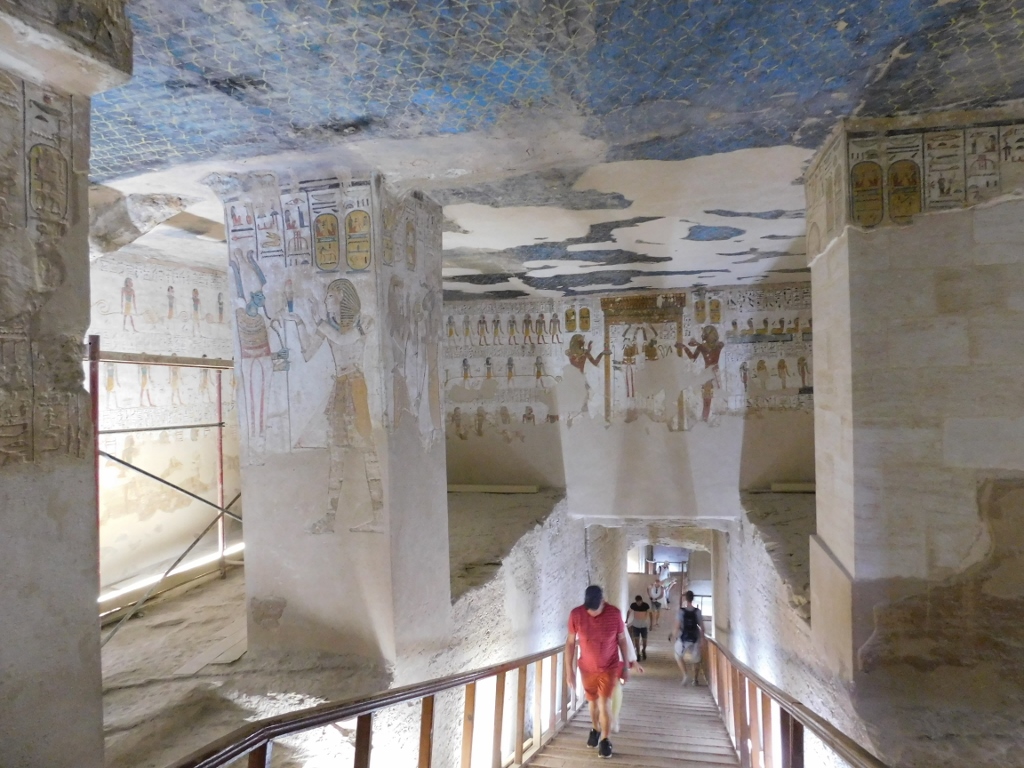 Tomb of Pharaoh Merenptah, a detail: central section
Tomb of Pharaoh Merenptah, a detail: central section
When the visitors get down to the end of the staircase, they reach a large room. It contains a stone sarcophagus, in which the pharaoh was originally buried, but in time his mummy, along with 18 other mummies, was transferred and hidden in a secret room in the tomb of Pharaoh Amenhotep II where it was found in 1898.
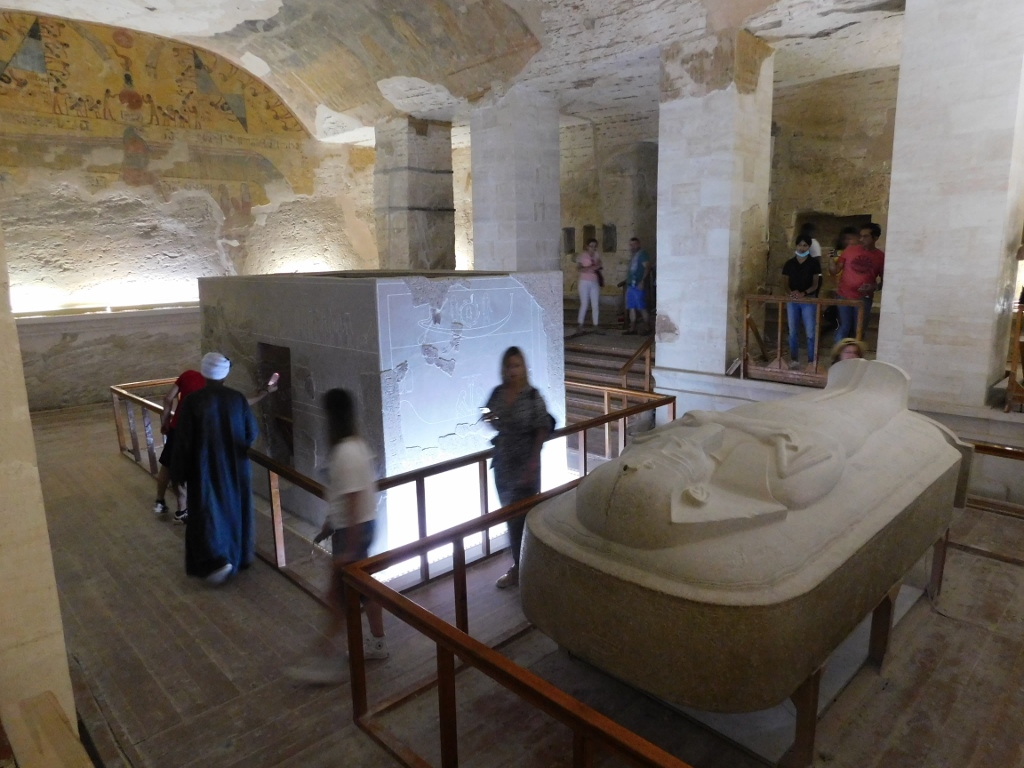 Tomb of Pharaoh Merenptah, a detail
Tomb of Pharaoh Merenptah, a detail
I stayed here for a short while, taking photos, and then I was supposed to go back to the entrance/exit, this time going UP the stairs. This can also be strenuous, because it is quite hot inside and it seems as if there were not enough air, but I must say I was impressed by my own fitness on this occasion.
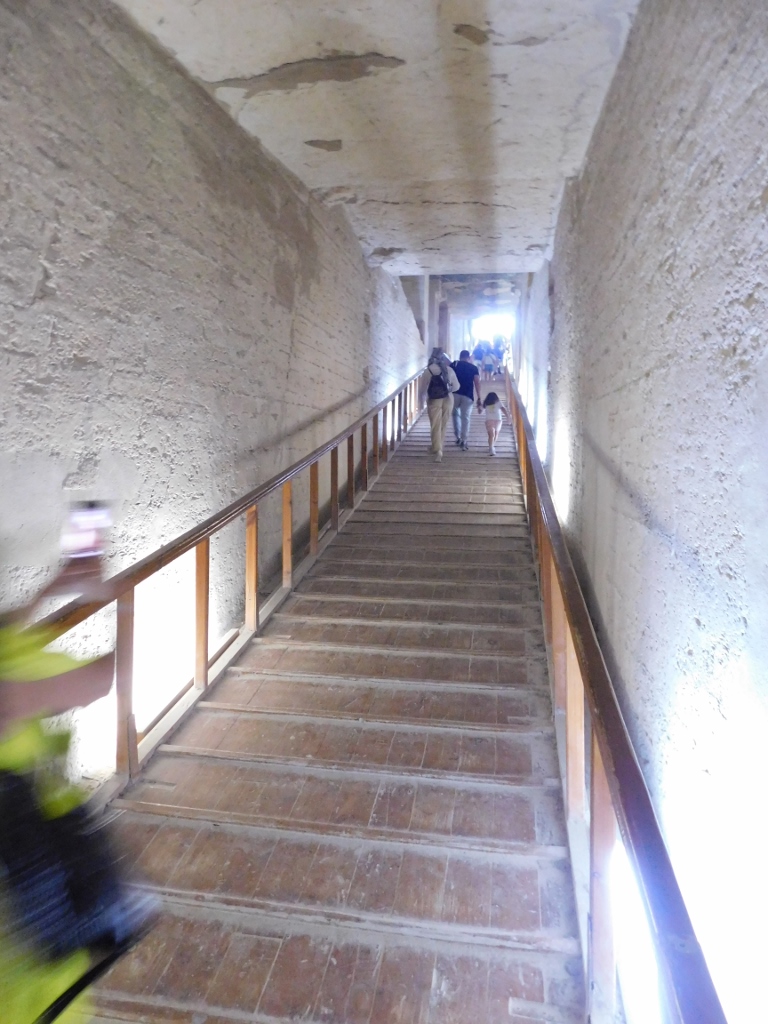 Tomb of Pharaoh Merenptah, stairs that lead up to the exit
Tomb of Pharaoh Merenptah, stairs that lead up to the exit
When I caught my breath, I went to the tomb of Pharaoh Ramesses IX. This pharaoh belonged to the 20th dynasty and ruled in the period from 1129 to 1111 BCE. His mummy also did not remain in its original place, but was transferred and hidden in another part of Western Thebes, where it was found in 1881.
Here, too, when you enter the tomb, on the left-hand side there is a depiction of the pharaoh, this time in the form of a relief. Here, the pharaoh addresses god Horus, behind whom there is Osiris.
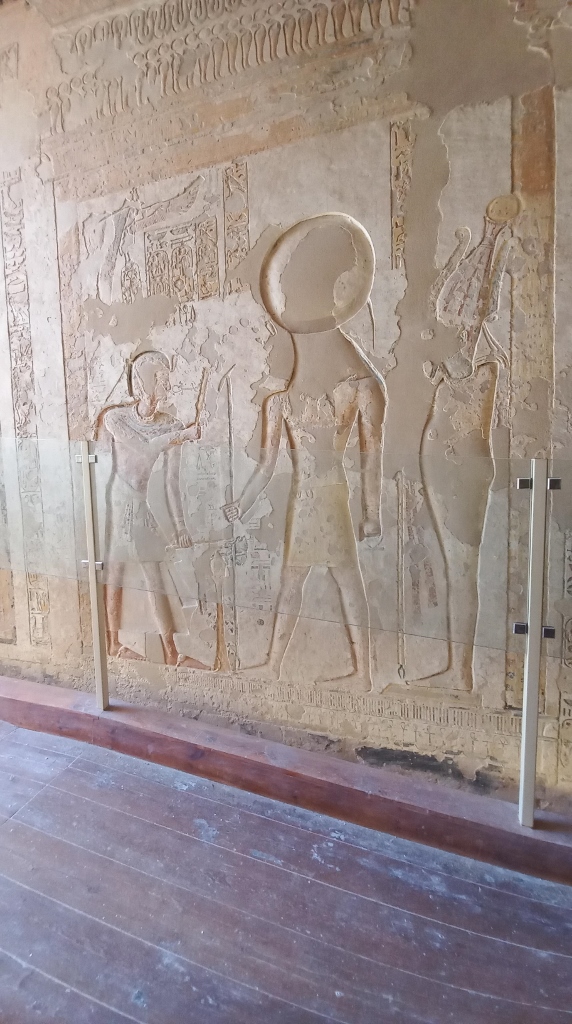 Tomb of Pharaoh Ramesses IX: the pharaoh with gods Horus and Osiris
Tomb of Pharaoh Ramesses IX: the pharaoh with gods Horus and Osiris
I have already mentioned god Horus several times, but now let me say something about god Osiris. He was the god of fertility, agriculture, as well as death, afterlife and rebirth.
And now, here are different photos that show details from the tomb of Ramesses IX. In the end, there is a short video.
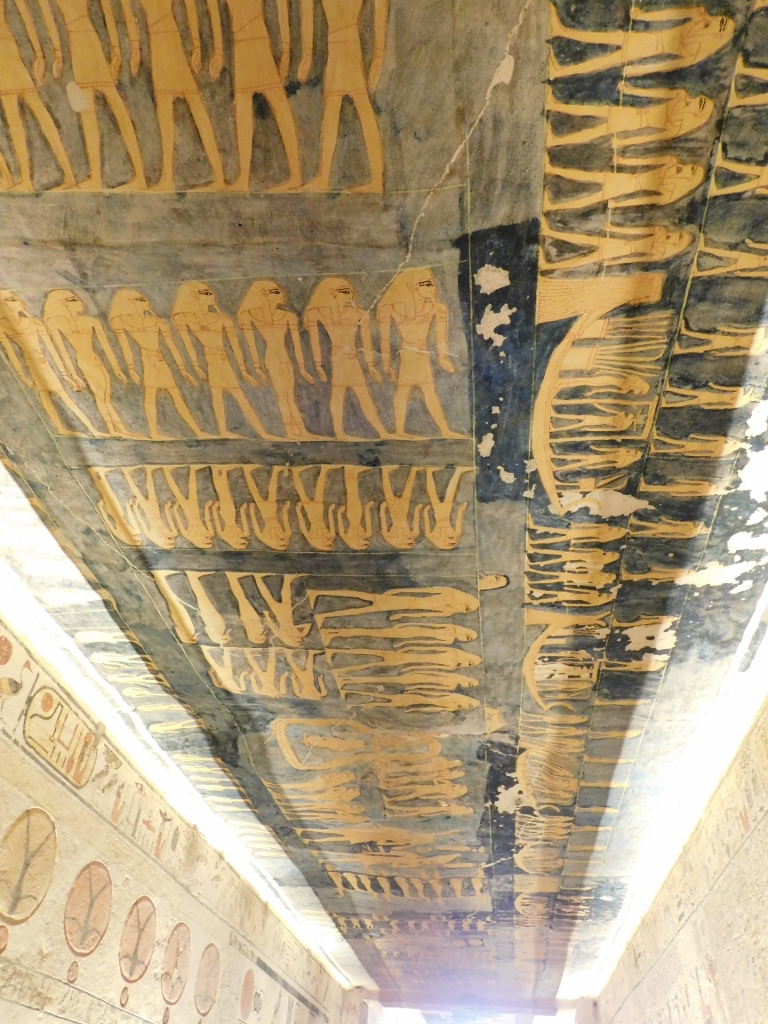 Tomb of Pharaoh Ramesses IX, a detail
Tomb of Pharaoh Ramesses IX, a detail
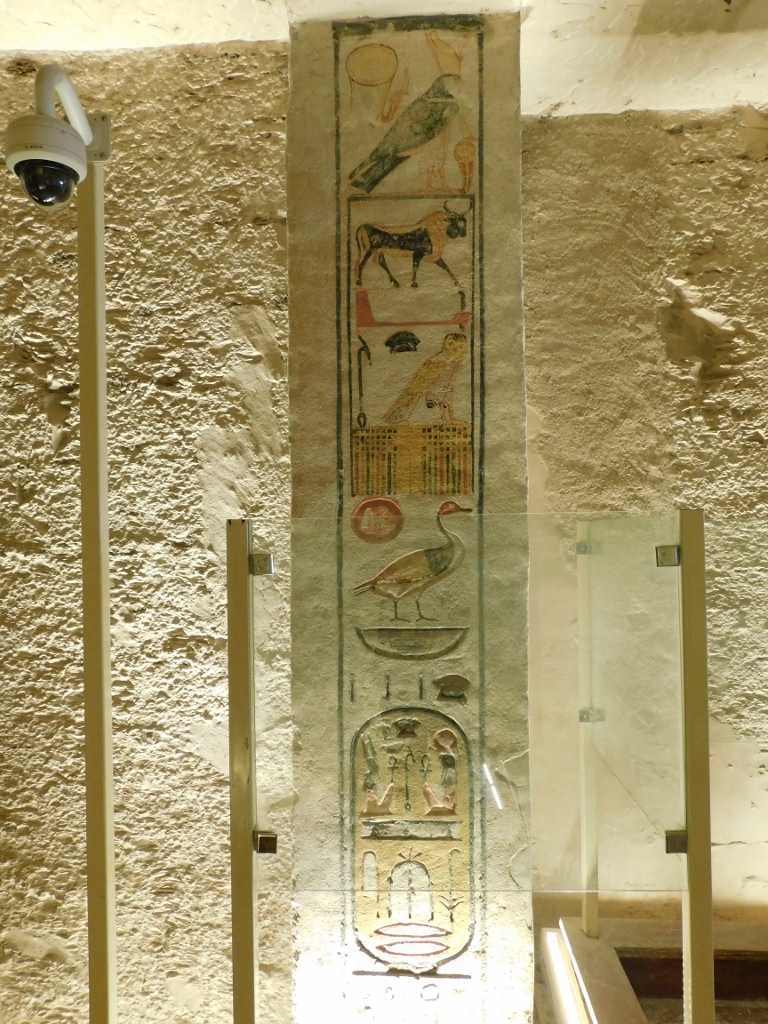 Tomb of Pharaoh Ramesses IX, a detail
Tomb of Pharaoh Ramesses IX, a detail
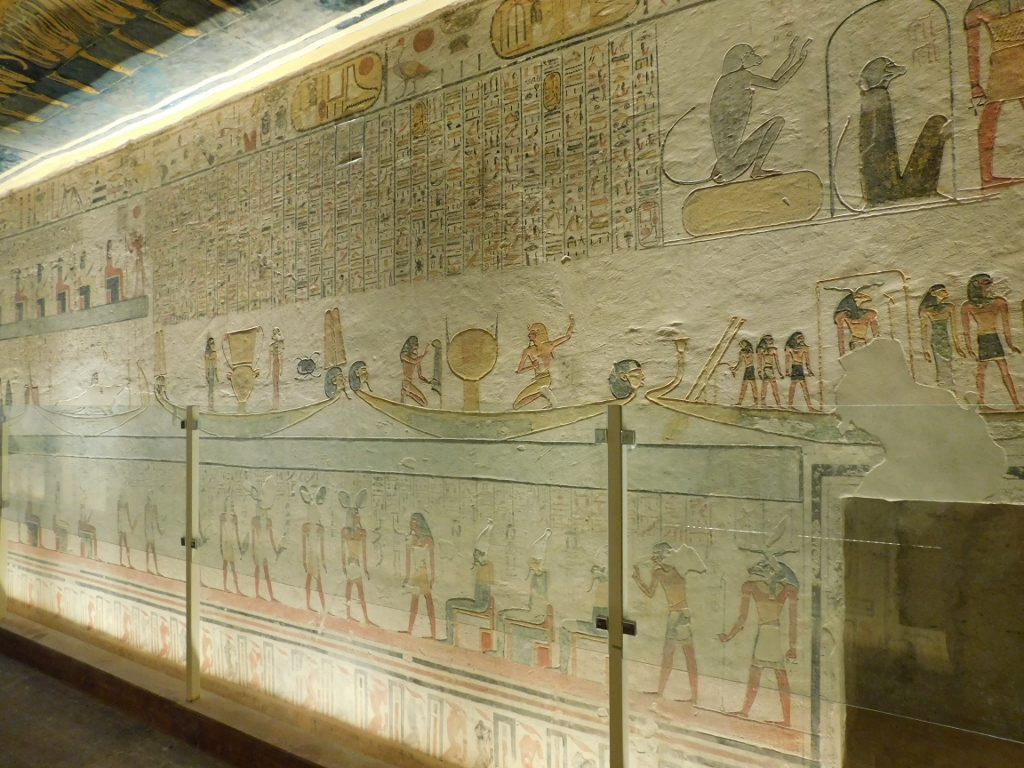 Tomb of Pharaoh Ramesses IX, a detail
Tomb of Pharaoh Ramesses IX, a detail
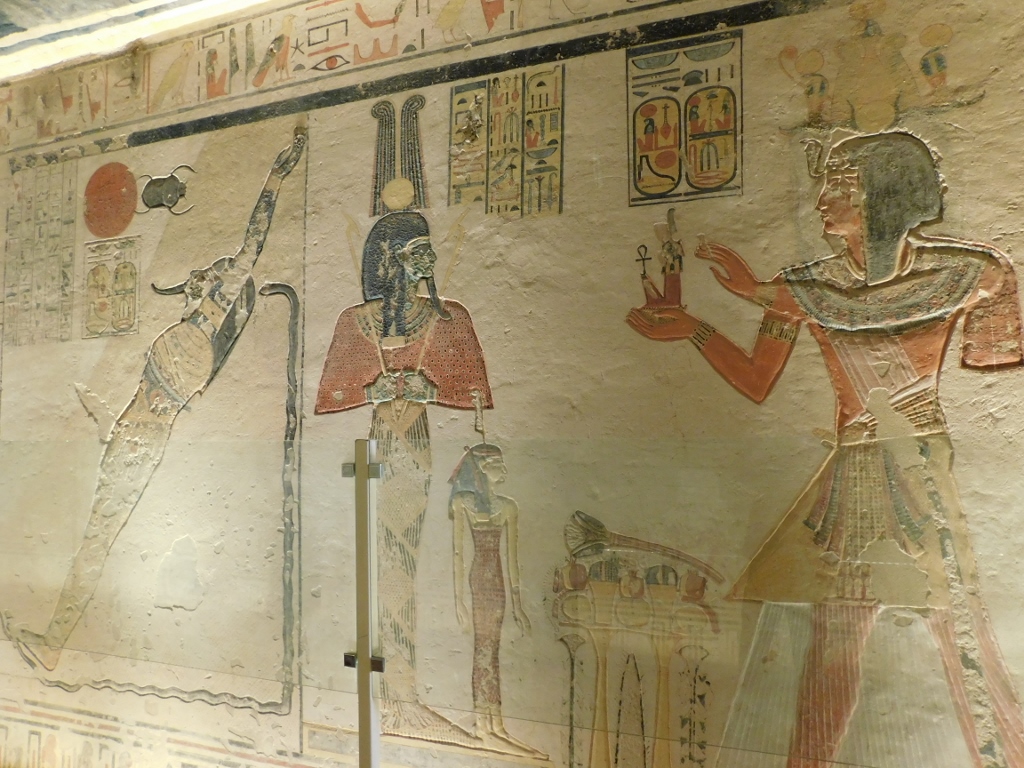 Tomb of Pharaoh Ramesses IX, a detail
Tomb of Pharaoh Ramesses IX, a detail
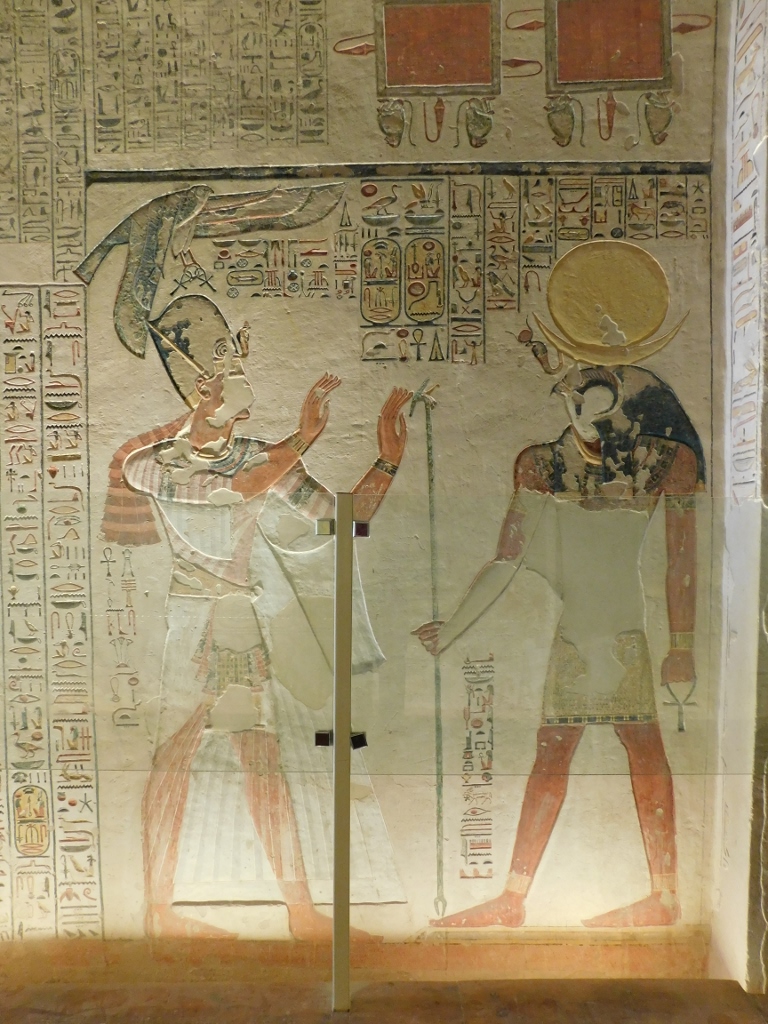 Tomb of Pharaoh Ramesses IX, a detail
Tomb of Pharaoh Ramesses IX, a detail
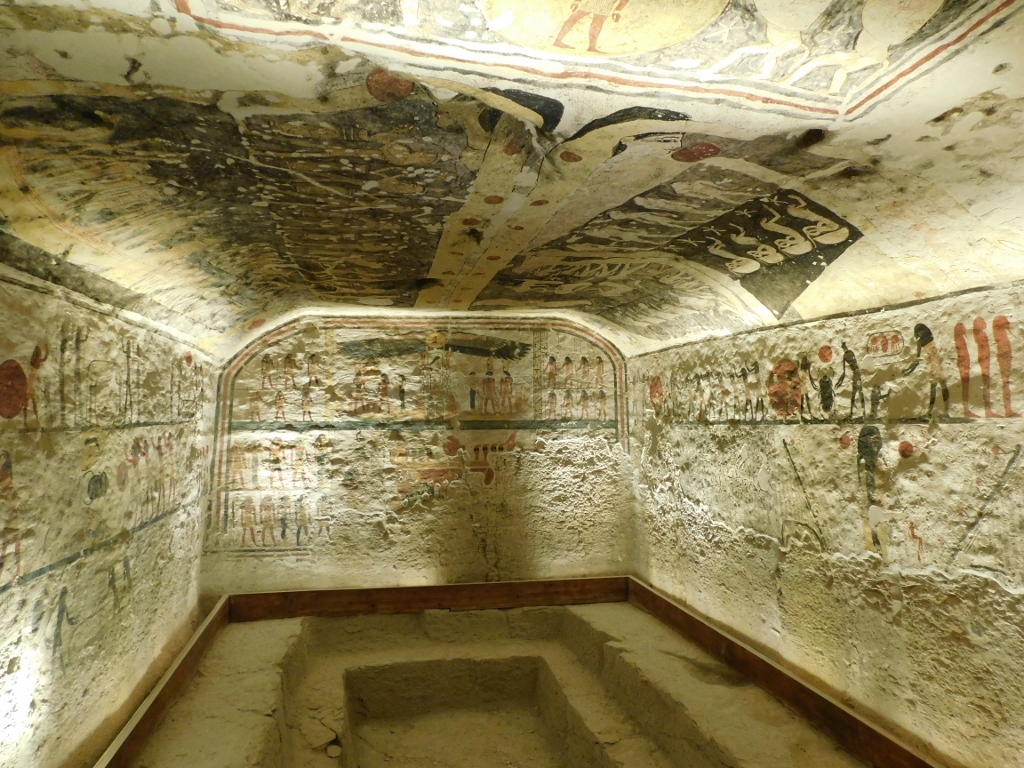 Tomb of Pharaoh Ramesses IX, the room in which the pharaoh was originally buried
Tomb of Pharaoh Ramesses IX, the room in which the pharaoh was originally buried
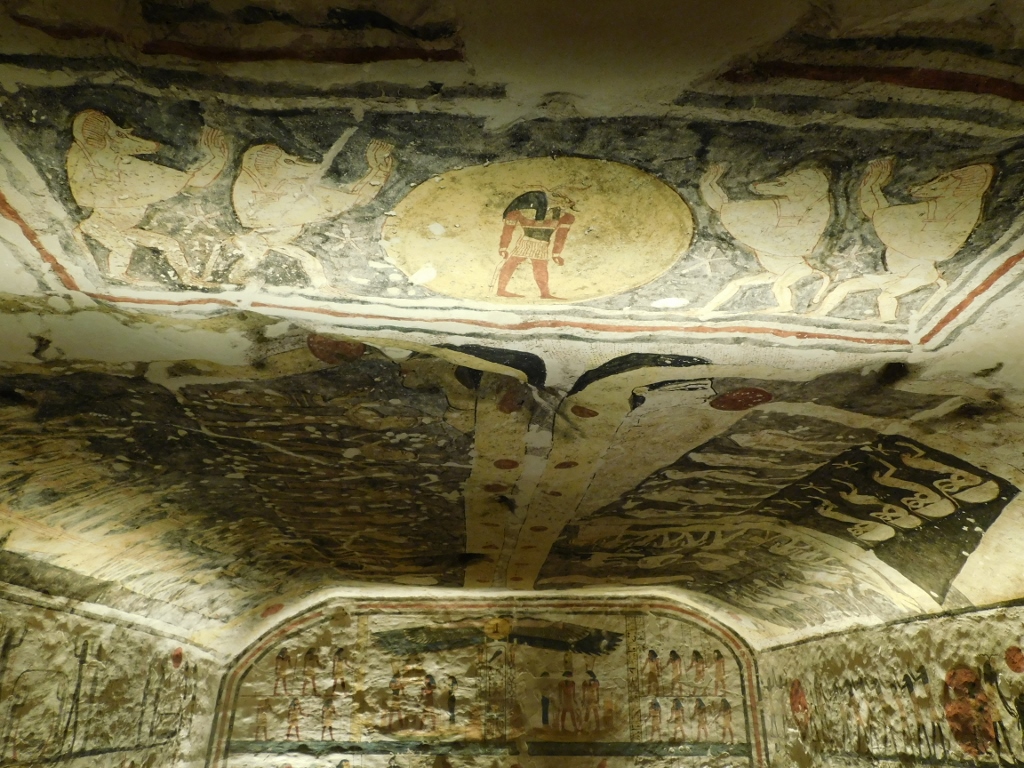 Tomb of Pharaoh Ramesses IX, the room in which the pharaoh was originally buried, a detail
Tomb of Pharaoh Ramesses IX, the room in which the pharaoh was originally buried, a detail
I had to interrupt my filming in order not to fall down the stairs, since it was vital for me to look where I was stepping. Once I had finished with the visit to the tomb, on my way out, I looked back several times and then I took photos of the first part of the corridor again. As I did that, suddenly I remained alone there. It was interesting to see what this all looks like when there are no visitors.
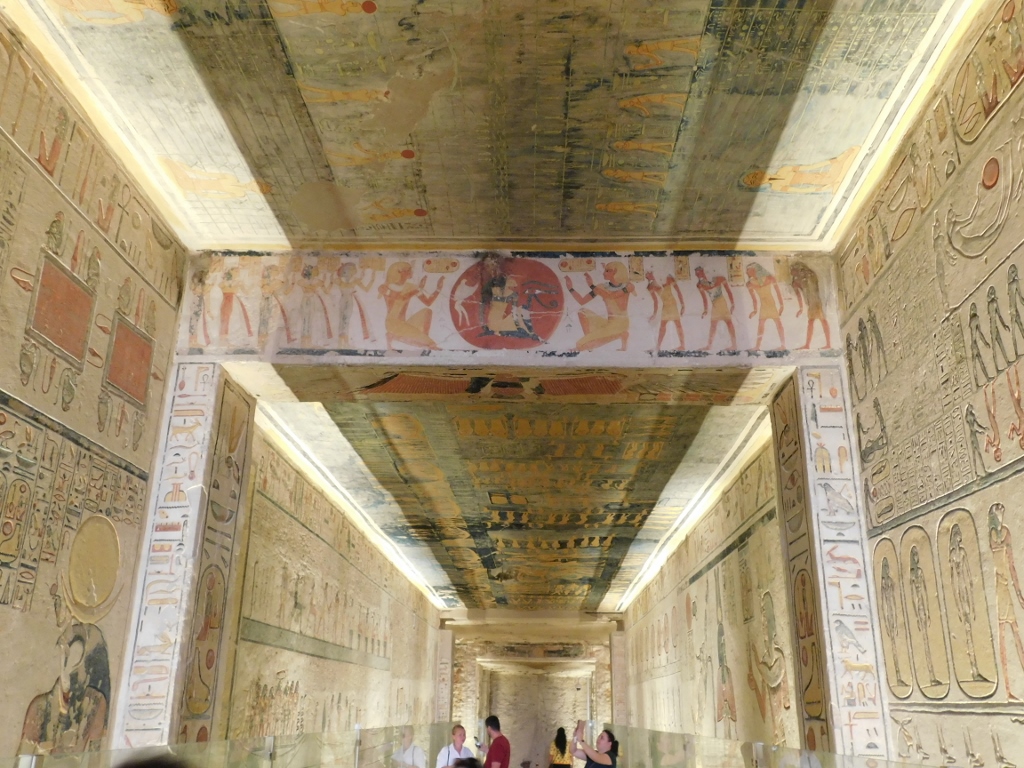 Tomb of Pharaoh Ramesses IX, a detail
Tomb of Pharaoh Ramesses IX, a detail
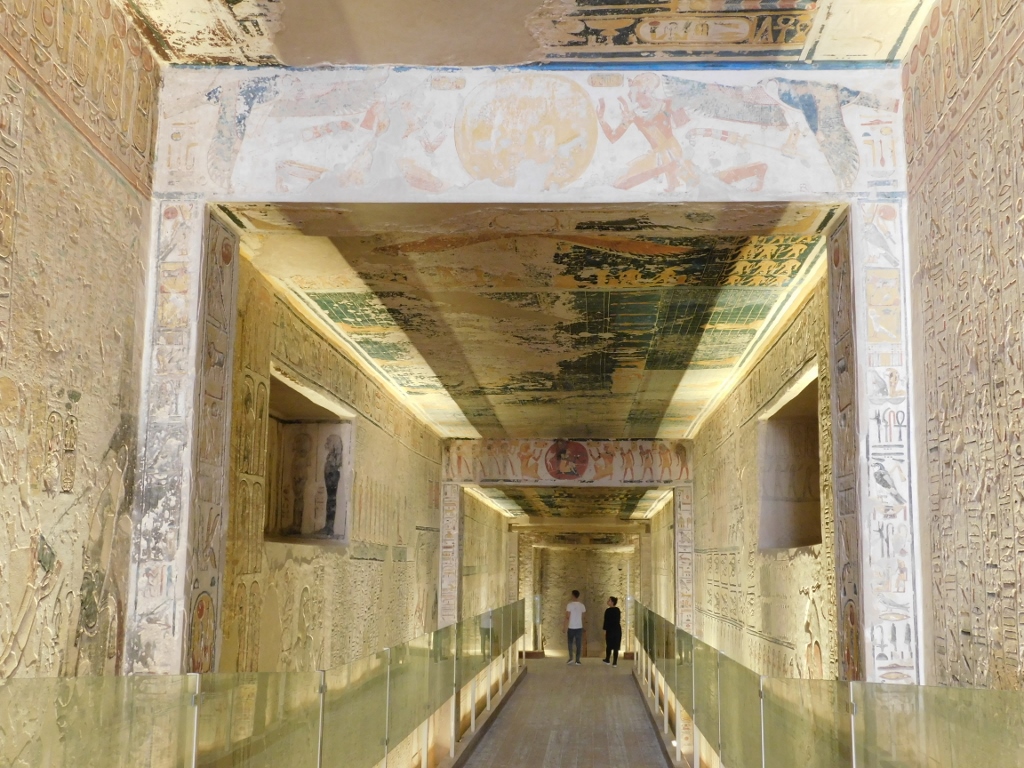 Tomb of Pharaoh Ramesses IX, a detail
Tomb of Pharaoh Ramesses IX, a detail
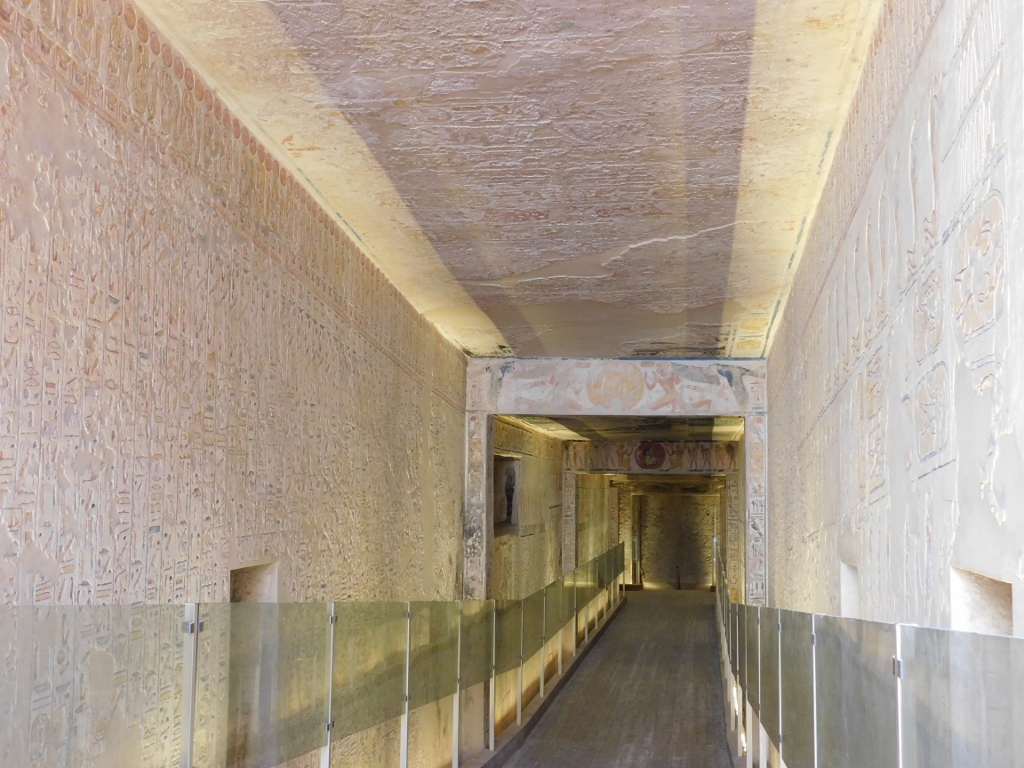 Tomb of Pharaoh Ramesses IX, a detail
Tomb of Pharaoh Ramesses IX, a detail
Then I saw that the tomb of Ramesses V/VI was close by. By the way, the tomb has this double designation because Ramesses V started with the construction, but then it was taken over and finished by Ramesses VI. They both belong to the 20th dynasty. Still, as it turned out, this was one of the tombs that required a special ticket and so I could not visit it. That’s why I went to the next one I knew was covered by the ticket I had.
This was the tomb of Pharaoh Ramesses III, also of the 20th dynasty. He ruled from 1186 to 1155 BCE. Most likely he was the grandfather of the afore-mentioned Ramesses IX. I have already mentioned Ramesses III before (https://www.svudapodji.com/en/egypt-7/). Namely, among other things, he also built a temple within the Karnak Temple Complex that is entered from the Great Court of the Temple of Amun. His mummy was found in 1886 by antiquarians and his sarcophagus made of red granite may be seen in Louvre, Paris. The tomb in which the pharaoh was buried is one of the largest in the Valley of the Kings. It is interesting that the corridor does not go straight, but breaks at some point. On the other hand, it was not possible to reach the very room in which the pharaoh was buried. All of that, as well as many other details, may be seen in the photos below and on the video.
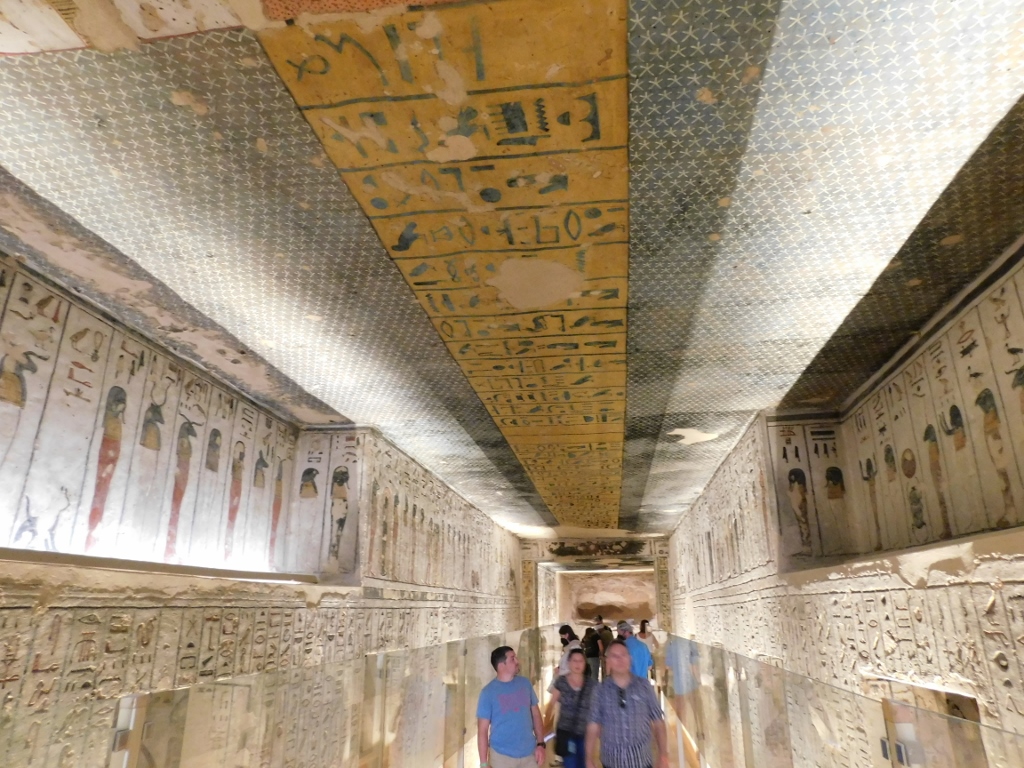 Tomb of Pharaoh Ramesses III, a detail
Tomb of Pharaoh Ramesses III, a detail
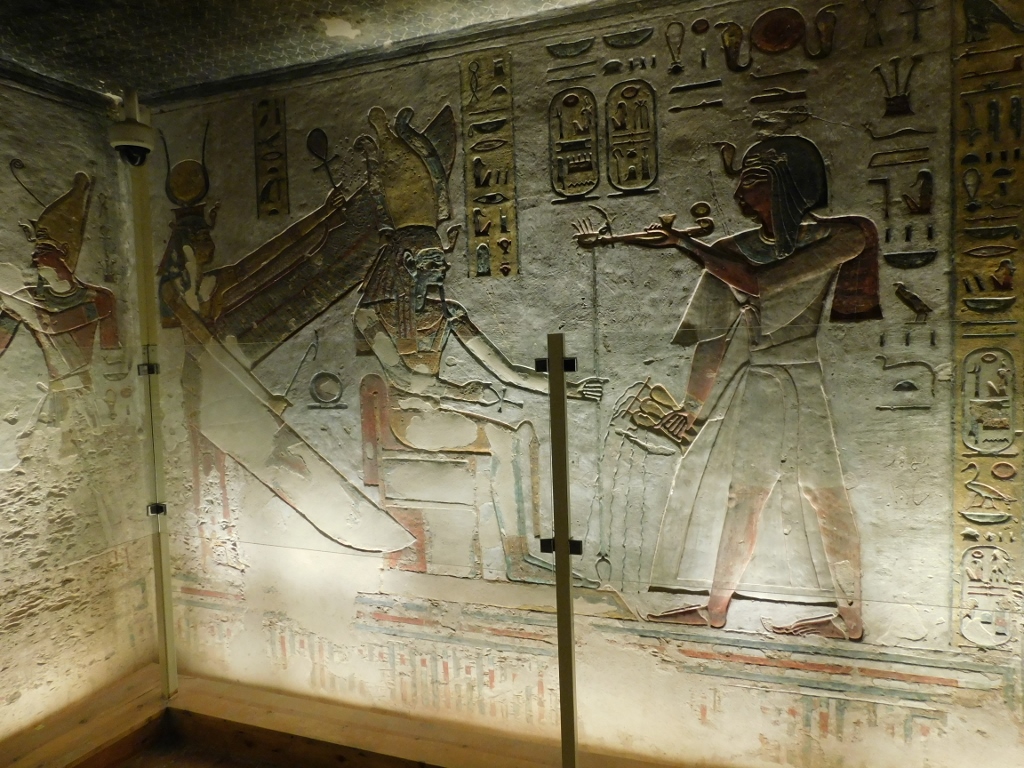 Tomb of Pharaoh Ramesses III, a detail
Tomb of Pharaoh Ramesses III, a detail
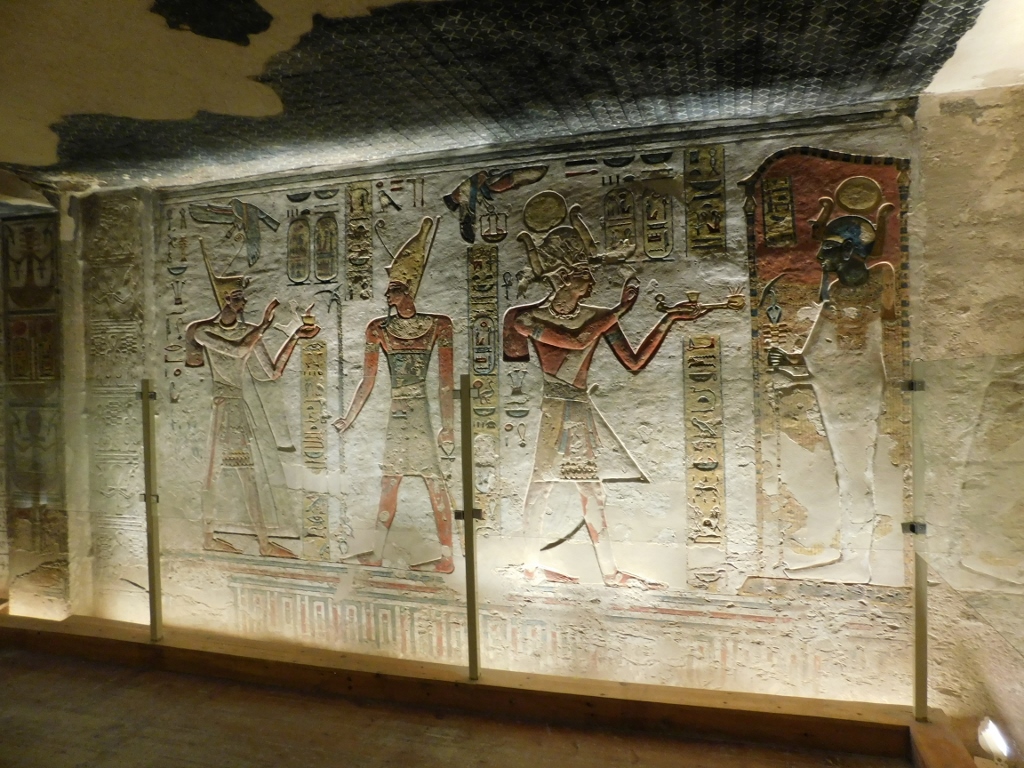 Tomb of Pharaoh Ramesses III, a detail
Tomb of Pharaoh Ramesses III, a detail
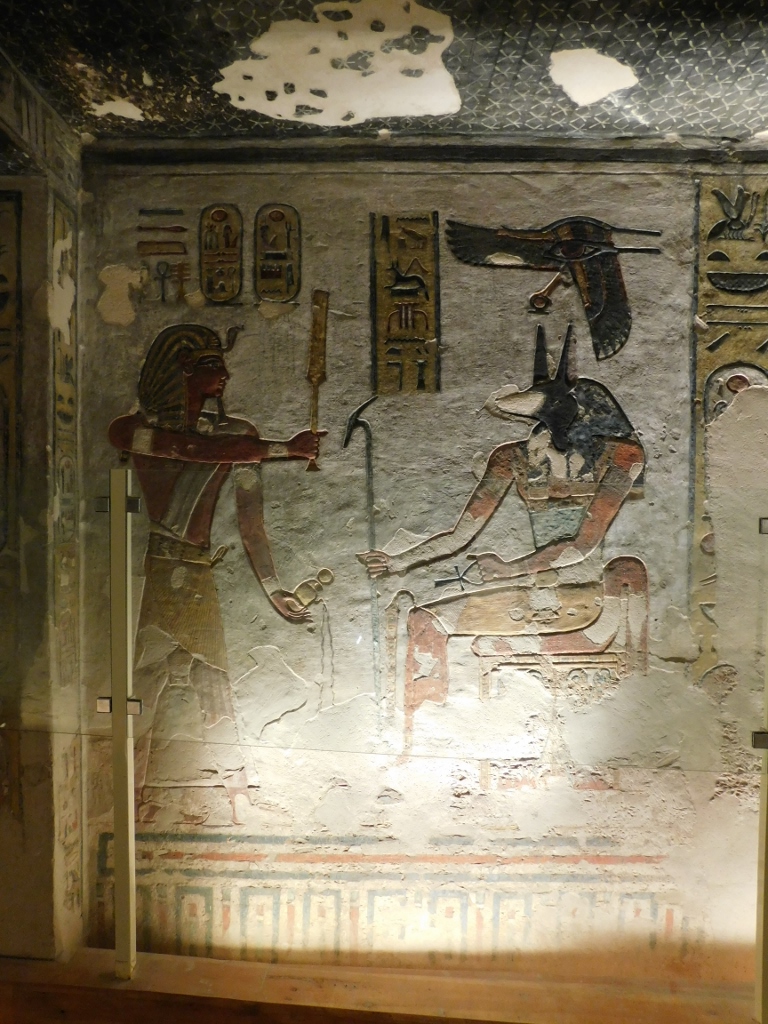 Tomb of Pharaoh Ramesses III, a detail
Tomb of Pharaoh Ramesses III, a detail
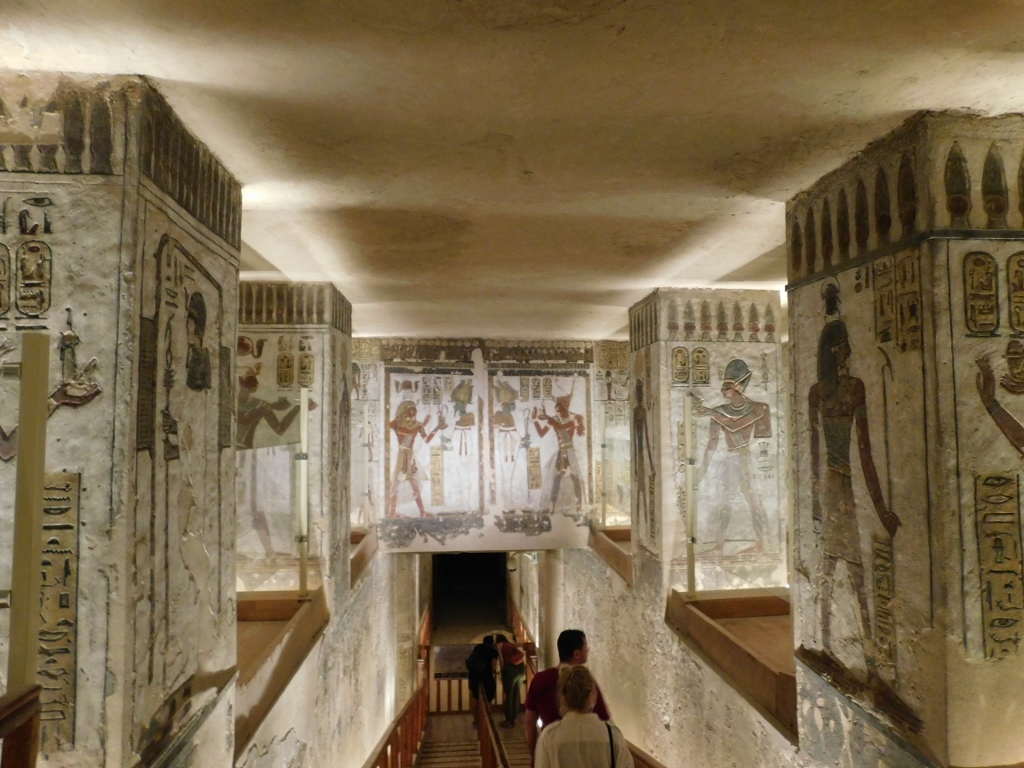 Tomb of Pharaoh Ramesses III, a detail
Tomb of Pharaoh Ramesses III, a detail
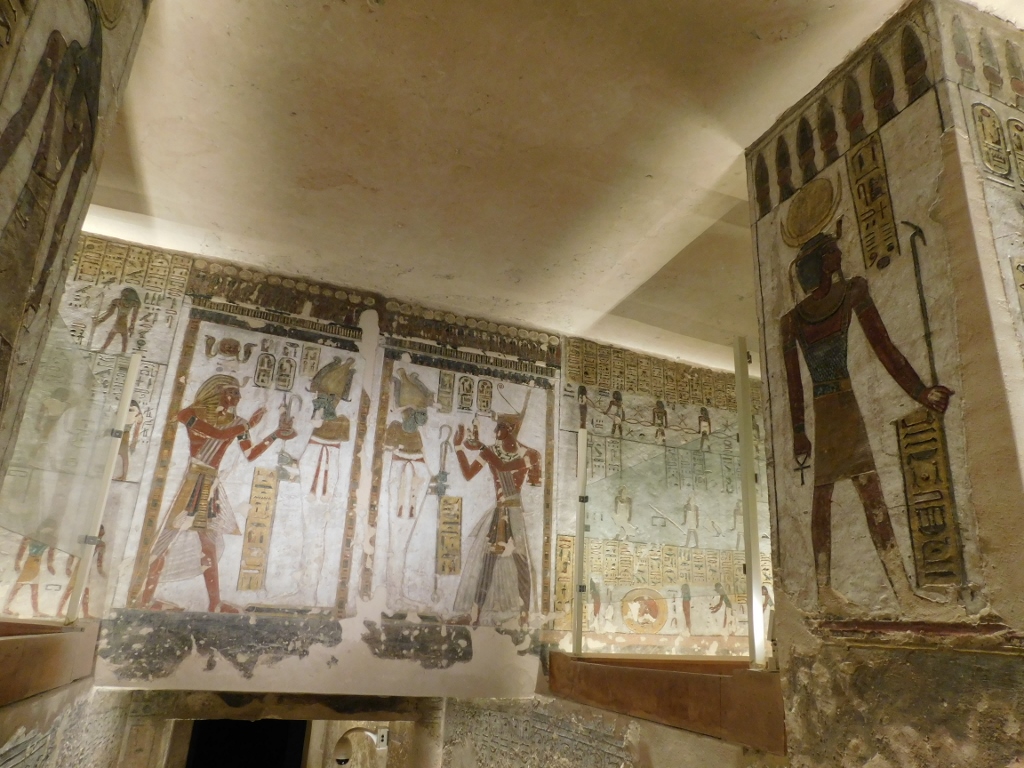 Tomb of Pharaoh Ramesses III, a detail
Tomb of Pharaoh Ramesses III, a detail
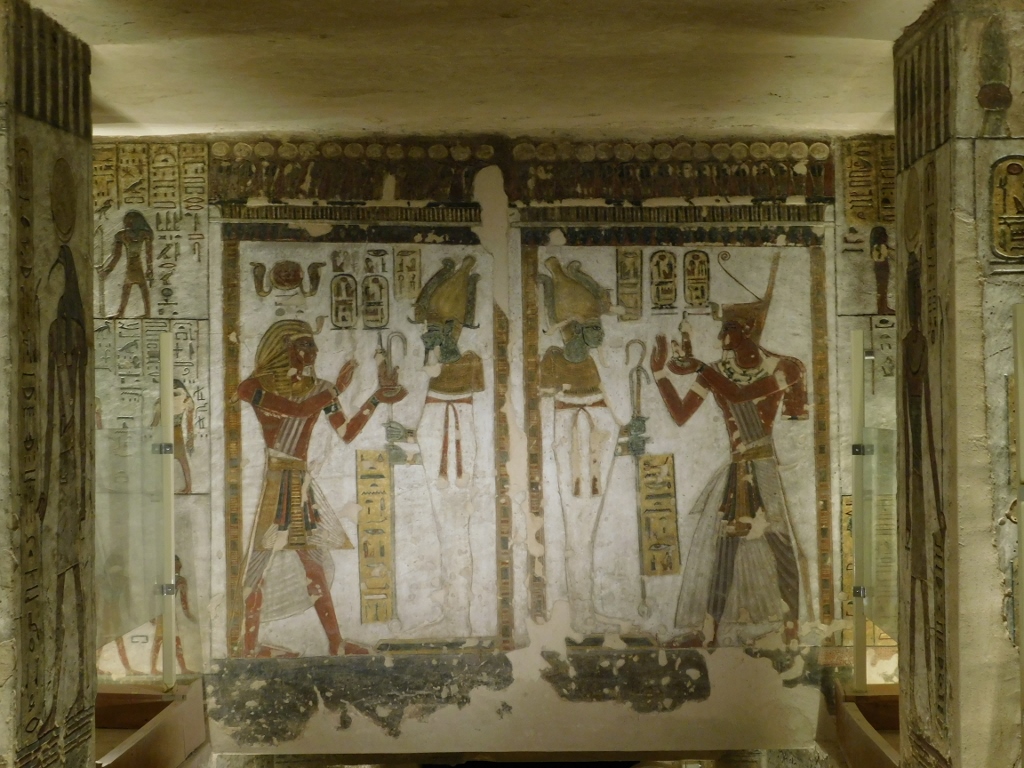 Tomb of Pharaoh Ramesses III, a detail
Tomb of Pharaoh Ramesses III, a detail
At the end of the video it is possible to see one of the side rooms. At the approach to that room there was a wooden barrier preventing free access. While I was standing there taking photos, I saw a guard who helped a girl climb over the fence. When the girl finished with her visit, he offered the same thing to me. I must admit that I accepted it. Generally speaking the guards are very much ready to allow visitors to see something not allowed otherwise, but they expect a tip. In other words, get your coins ready (1-2 euros) and start with the sightseeing.
Although by the rule I am a very conscientious person and even “unbending,” every now and then I give myself a “permission” to be naughty and this was the case here with my climbing over the fence (although I certainly did not touch anything and left no trace of my visit, except for the digital one). In the end, the guard showed me with his finger across his lips that I should not talk about this, because he did it “only for me.” Since it is clear that this is a total BS, after all I saw with my own eyes the girl who went to that room before me, I don’t feel bad at all for writing about the experience. Here is also a photograph from the room:
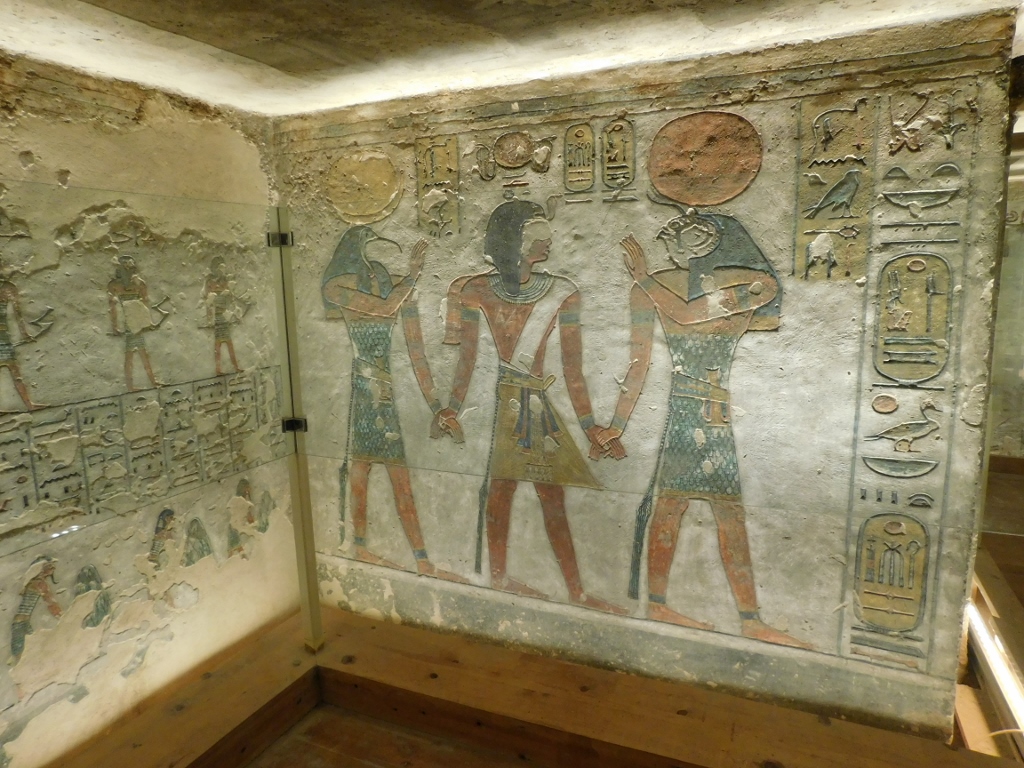 Tomb of Pharaoh Ramesses III, a detail
Tomb of Pharaoh Ramesses III, a detail
Here I also finished with my visits to the tombs in the Valley of the Kings in 2021. Still, here are a few other photos I took back in 2001, but I don’t know which tomb this was. Obviously, some that is very impressively decorated.
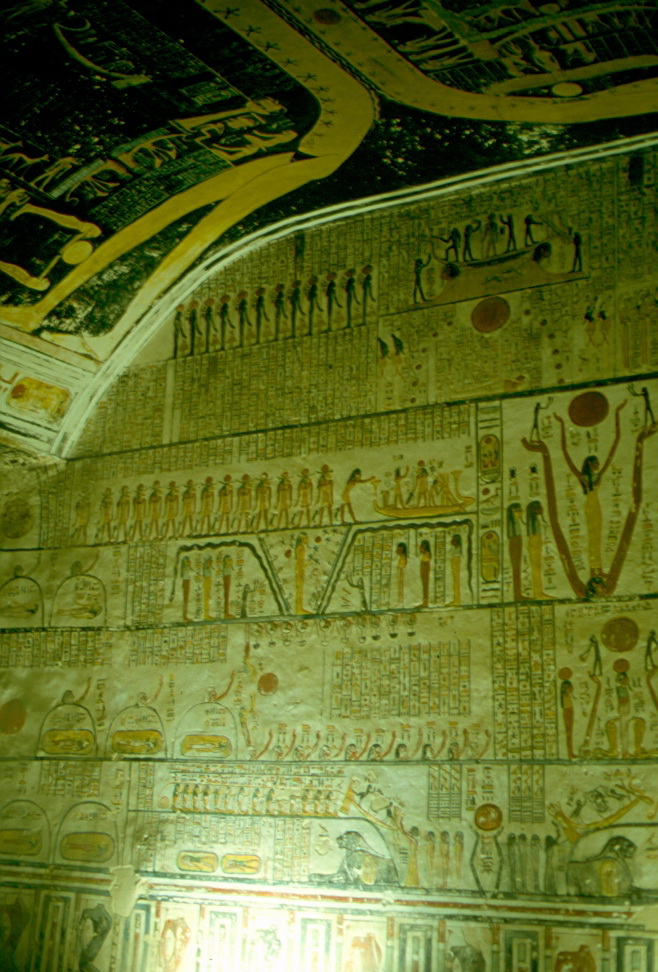 Tomb in the Valley of the Kings that I visited in 2001
Tomb in the Valley of the Kings that I visited in 2001
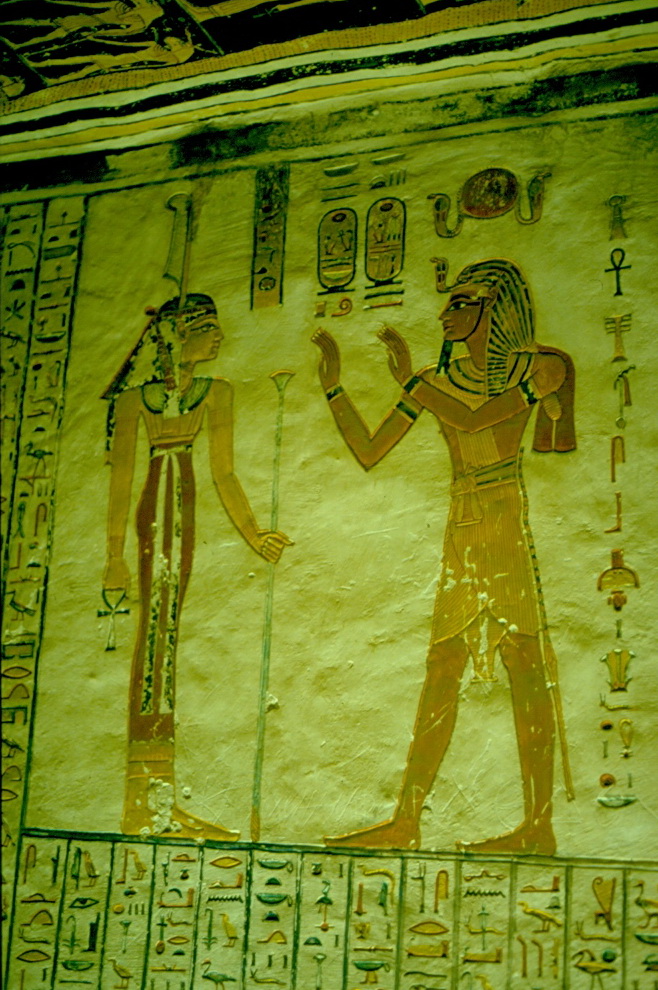 Tomb in the Valley of the Kings that I visited in 2001
Tomb in the Valley of the Kings that I visited in 2001
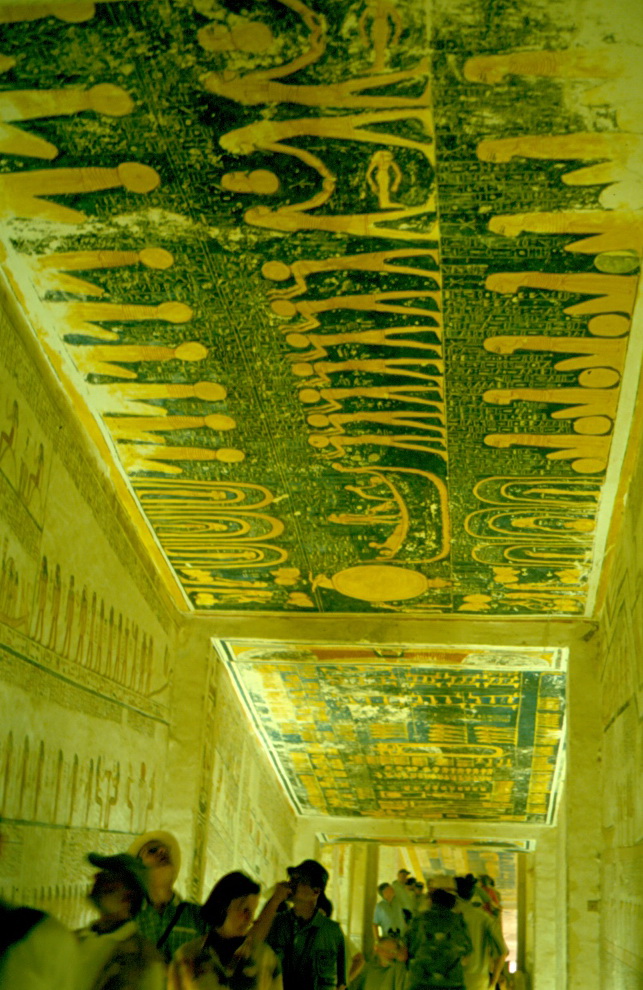 Tomb in the Valley of the Kings that I visited in 2001
Tomb in the Valley of the Kings that I visited in 2001
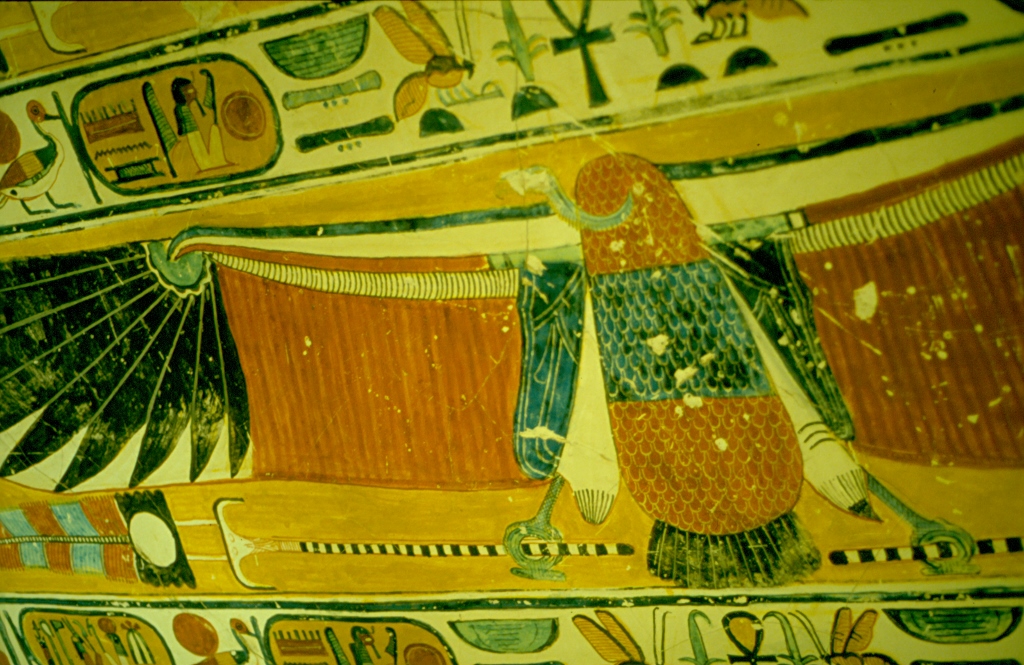 Tomb in the Valley of the Kings that I visited in 2001
Tomb in the Valley of the Kings that I visited in 2001
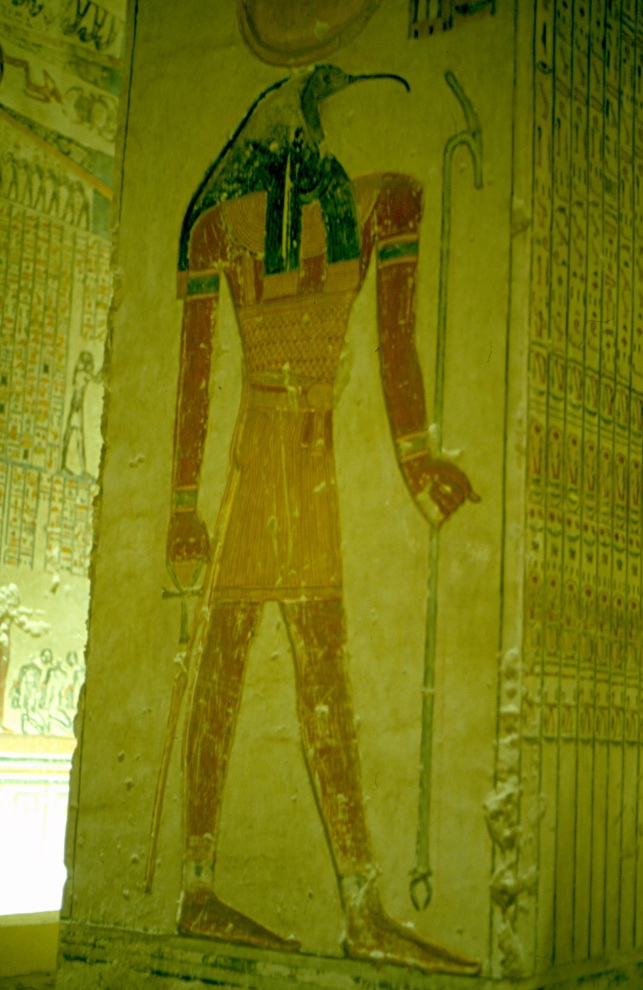 Tomb in the Valley of the Kings that I visited in 2001
Tomb in the Valley of the Kings that I visited in 2001
The group gathered up again and then we went by the mini-bus to the next site on our tour. Along the way it is possible to see a myriad of structures built on the slopes of the surrounding hills. Some of them are tombs of less important, but still high enough positioned individuals to deserve their place in Western Thebes, while some others are settlements inhabited by workers, craftsmen and artisans.
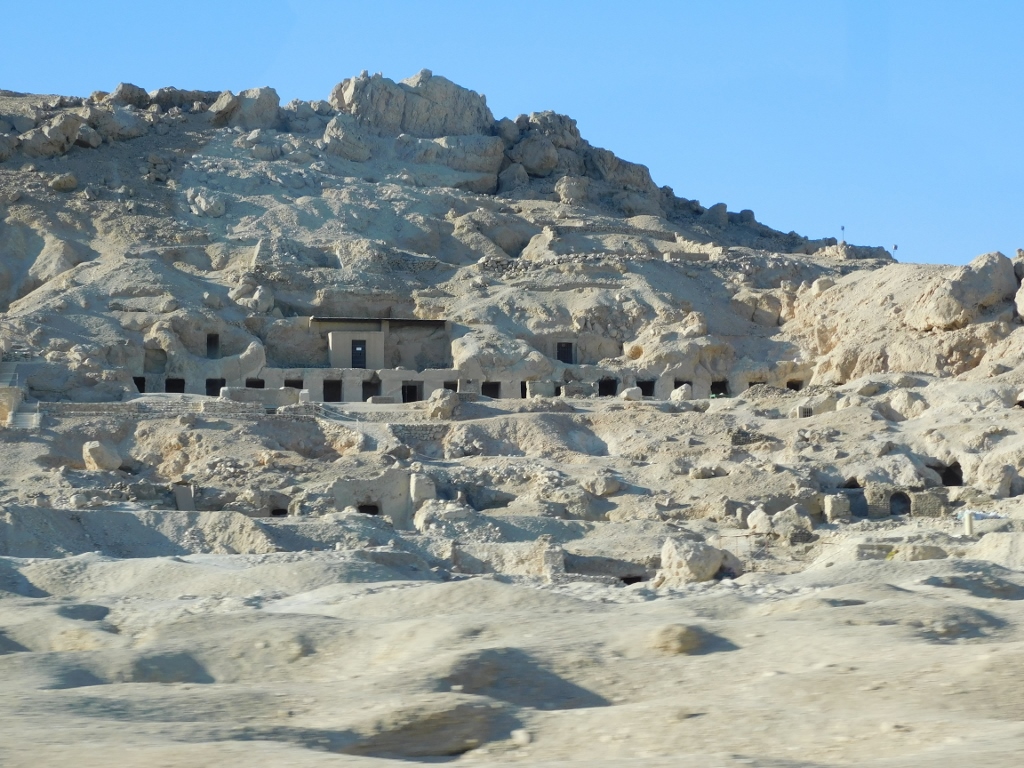 Myriad of archaeological remains from Ancient Egypt
Myriad of archaeological remains from Ancient Egypt
Then we came to the archaeological complex Deil el-Bahari with the Mortuary Temple of Hatshepsut.

The temple is situated at the foot of a rocky hill and the visitor can walk to it from the ticket office, but there is also a small electric train (on the right-hand side in the photo above). Still, at some point one has to walk, which is more than ok.
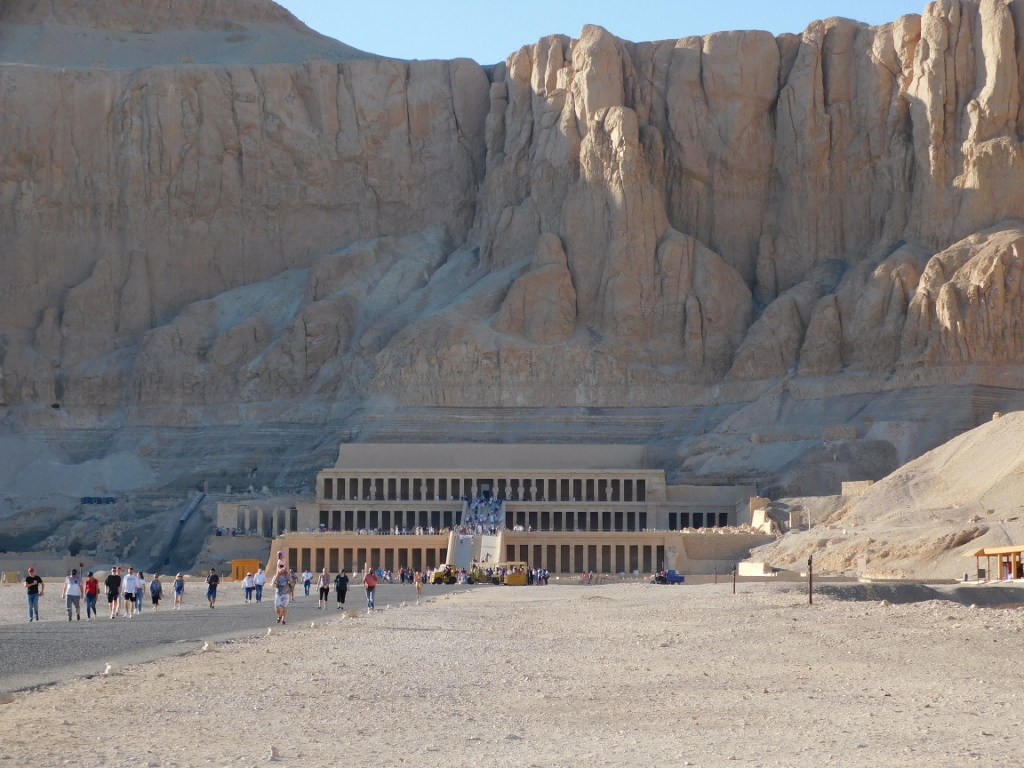 Getting close to the Temple of Hatshepsut
Getting close to the Temple of Hatshepsut
Queen, or rather, Pharaoh Hatshepsut was the fifth ruler of the 18th Ancient Egyptian dynasty. She was not the first woman to rule Ancient Egypt (it has been historically established that she was the second; the first was Sobekneferu of the 12th dynasty). She ruled from around 1479 to 1458 BCE, i.e., 3500 years ago!
Hatshepsut was the main wife of Pharaoh Thutmose II, who was also her brother (I have already mentioned that this was quite a common practice in Ancient Egypt, the logic of it being that the “quality of the blood” was kept at the highest level in this way – what a joke!). The two of them had only one daughter and the heir apparent of Thutmose II was Thutmose III whom the pharaoh got with one of the other official wives. When Thutmose II passed away, Thutmose III was only 2. And so, Hatshepsut, who was like her brother and husband, Thutmose II, a daughter of the previous pharaoh, Thutmose I, thus having the “pedigree” par excellence, simply continued to rule instead of her nephew. And she kept doing it for over 20 years.
During that period she built numerous temples and is believed to be one of the most prolific builders among the pharaohs. The pinnacle of her building activity is precisely the Temple of Hatshepsut. Needless to say, there were many images and statues of the pharaoh herself, but after her death this was all destroyed or removed. Namely, I have already mentioned before that most often people say that her nephew and heir, Thutmose III, ordered the image of his aunt and predecessor to be removed from all the structures where it was depicted (admittedly, only where she was depicted as a pharaoh; where she was depicted as a queen, as in pharaoh’s wife, her image was left intact). Nowadays, the scientists are not so sure about the reasons for all of this (it was done only some 20 years into the reign of Thutmose III). Still, with its beautiful and impressive colonnades, the temple still stands tucked against the foot of the practically vertical cliffs.
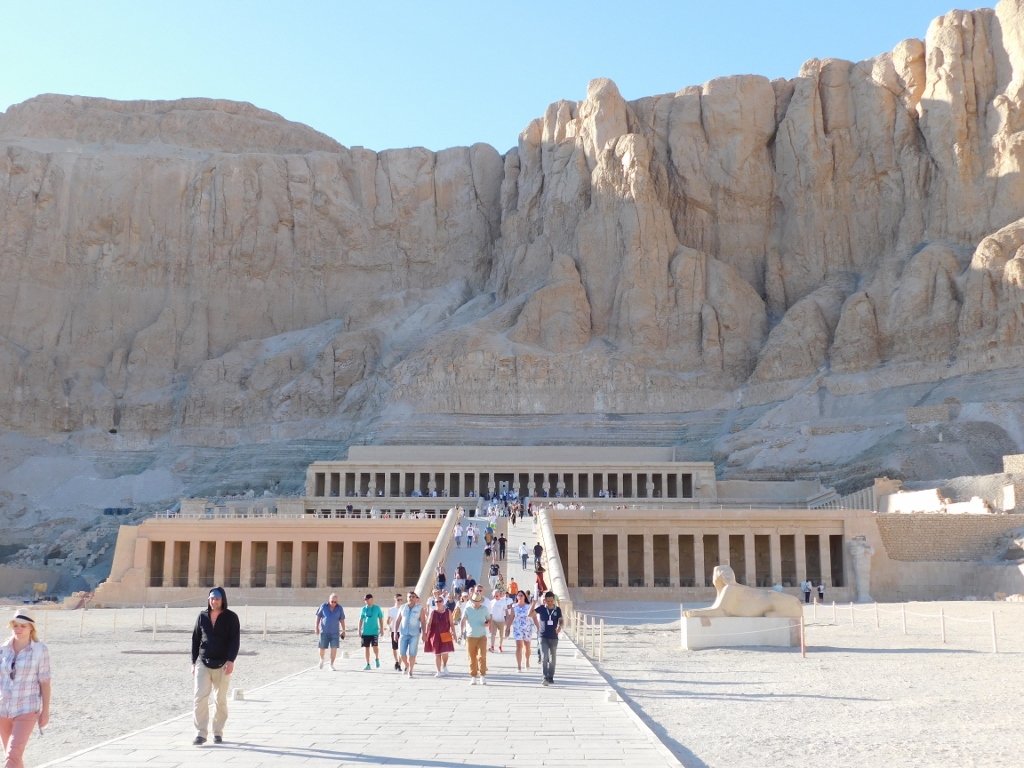 Temple of Hatshepsut, Lower Court
Temple of Hatshepsut, Lower Court
This architectural masterpiece from the Antiquity consists of three large terraces. In the photo above, the foreground shows the Lower Court where in the past there used to be gardens with fountains. Now, there is a lonely sphinx (in the photo above to the right from the path) and there are certainly the lower colonnades.
Going along the first ramp you reach the second terrace, i.e., the Middle Court. There are also two sets of colonnades (to the left and right from the second ramp), while further to the left and right there are the Shrine of Hathor (all the way to the left) and the Shrine of Anubis (all the way to the right).
 Temple of Hatshepsut, Middle Court
Temple of Hatshepsut, Middle Court
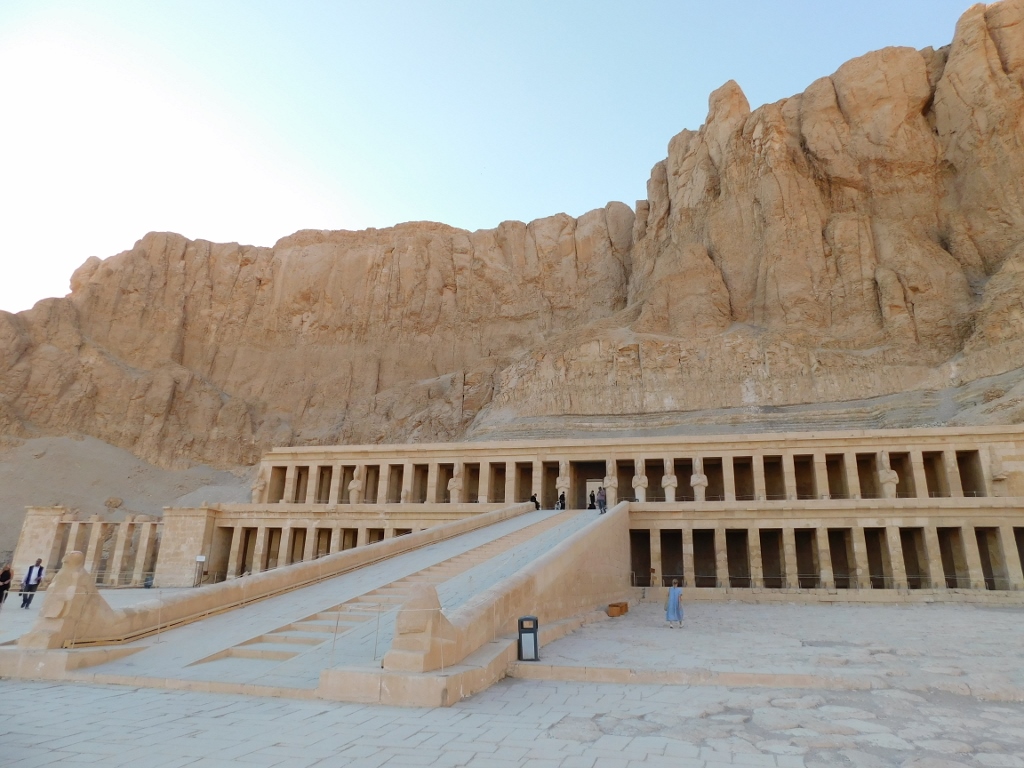 Temple of Hatshepsut, Middle Court
Temple of Hatshepsut, Middle Court
First I went left to the Shrine of Hathor. As soon as you approach the porch, you can see a relief on the wall where there is a depiction of Hatshepsut feeding the goddess (goddess Hathor is depicted as a cow). I have already mentioned before that Hathor was one of the main goddesses and the symbol of the motherly aspect.
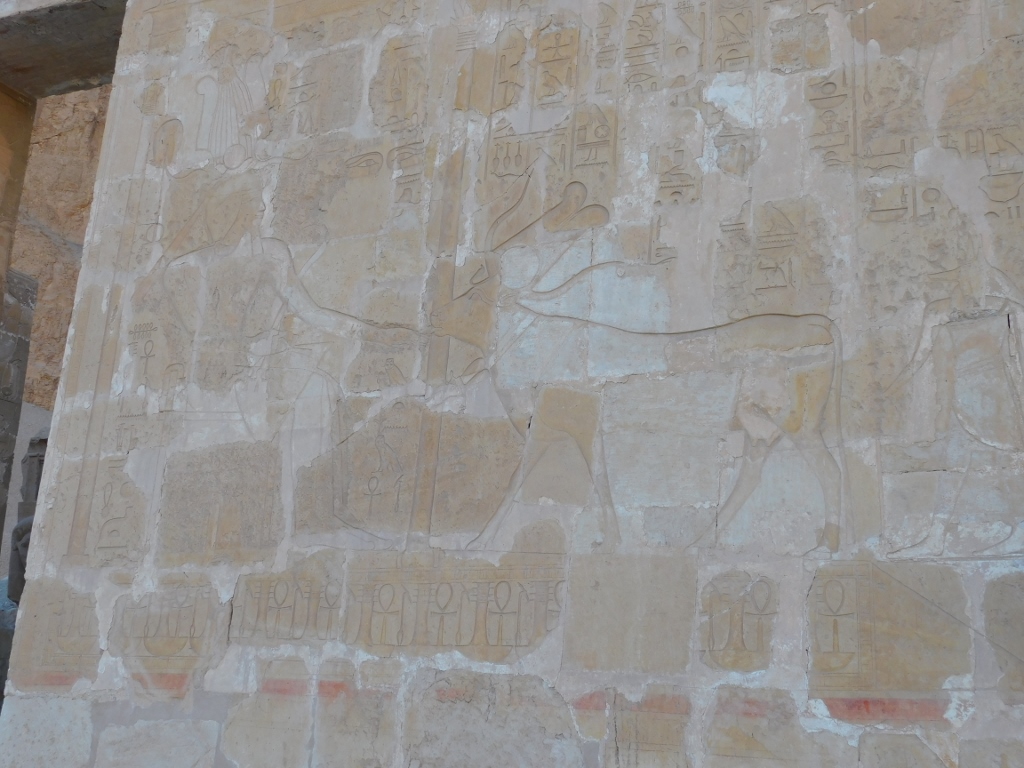 Temple of Hatshepsut, relief with Hatshepsut and goddess Hathor
Temple of Hatshepsut, relief with Hatshepsut and goddess Hathor
But, when you get to the pillars at the front side of the temple, you can see the other way of depicting the goddess – as a human image – which is rather popular and is ubiquitously copied.
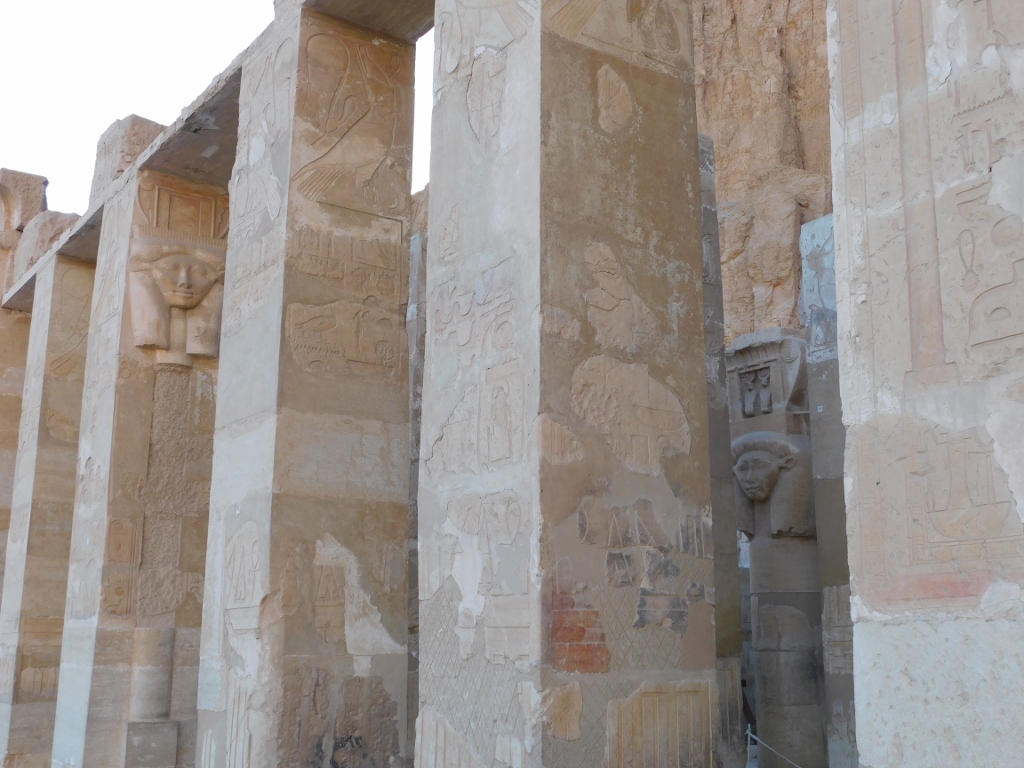 Shrine of goddess Hathor
Shrine of goddess Hathor
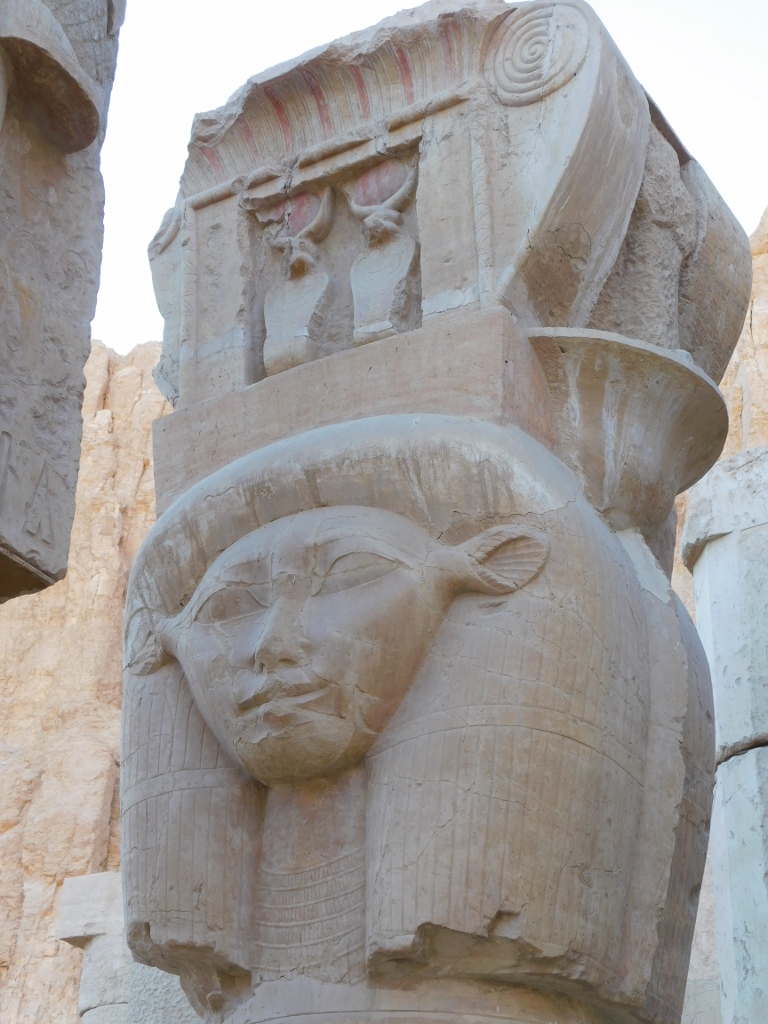 Goddess Hathor
Goddess Hathor
I was here also back in 2001 and this is what it all looked like in the middle of the day.
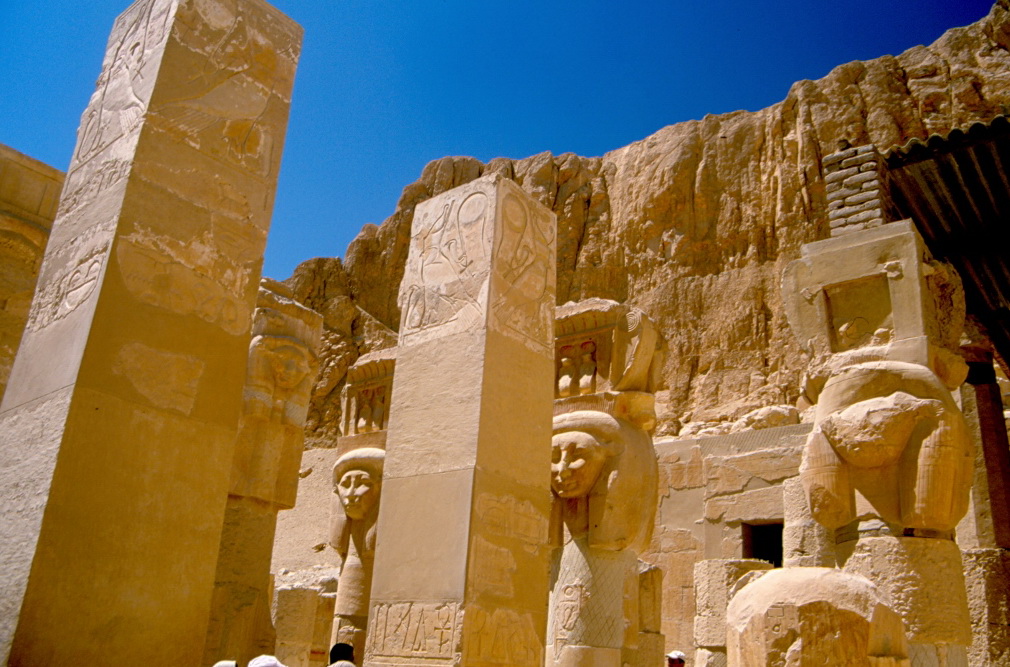
Shrine of goddess Hathor
Inside the shrine, there are also reliefs that depict the relation between the goddess and the pharaoh in a different way, although still as very close.
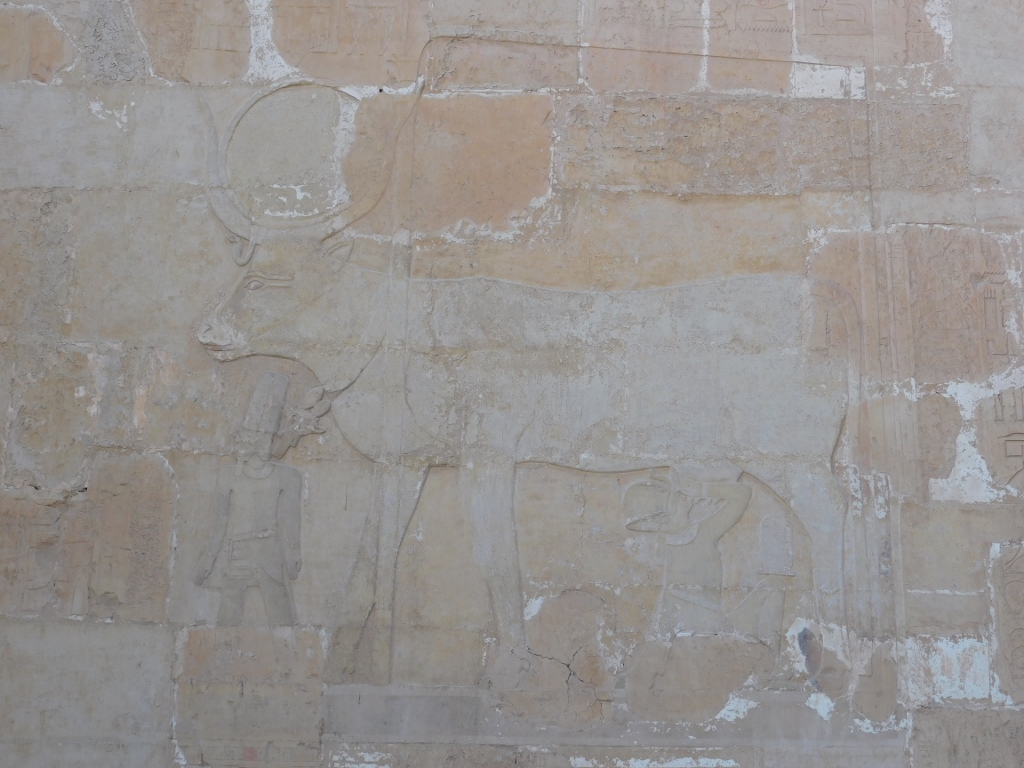 Relief within the Shrine of goddess Hathor
Relief within the Shrine of goddess Hathor
In front of the shrine there is a terrace and when you get to its end you can see the remains of the Temple of Mentuhotep II (pharaoh of the 11th dynasty). Originally, that temple also had several levels and in fact it served as the paragon for the Temple of Hatshepsut, although it had been built 6 centuries earlier. These two temples were practically positioned one next to the other. Today, this is just an archaeological site.
 Remains of the Mortuary Temple of Pharaoh Mentuhotep II
Remains of the Mortuary Temple of Pharaoh Mentuhotep II
Then I went back to the second ramp where Horus awaited me, while a local guy was moving around. Then he started to insist I took a photo of him. A handsome man!
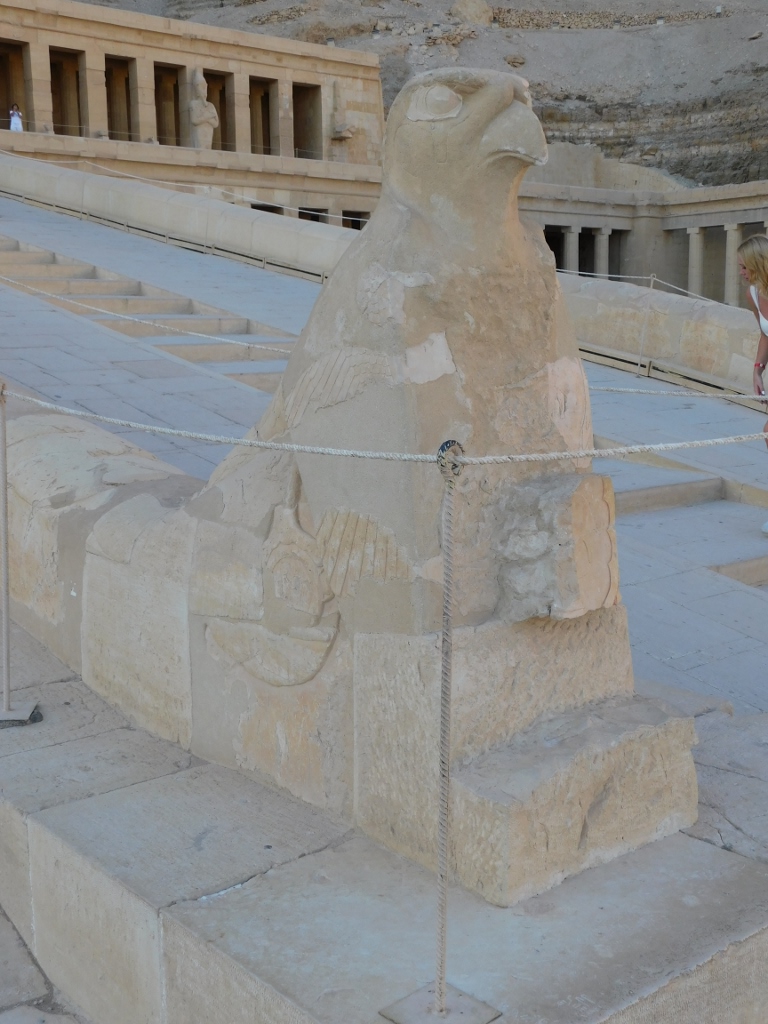 Temple of Hatshepsut, Horus beside the ramp leading to the Upper Court
Temple of Hatshepsut, Horus beside the ramp leading to the Upper Court
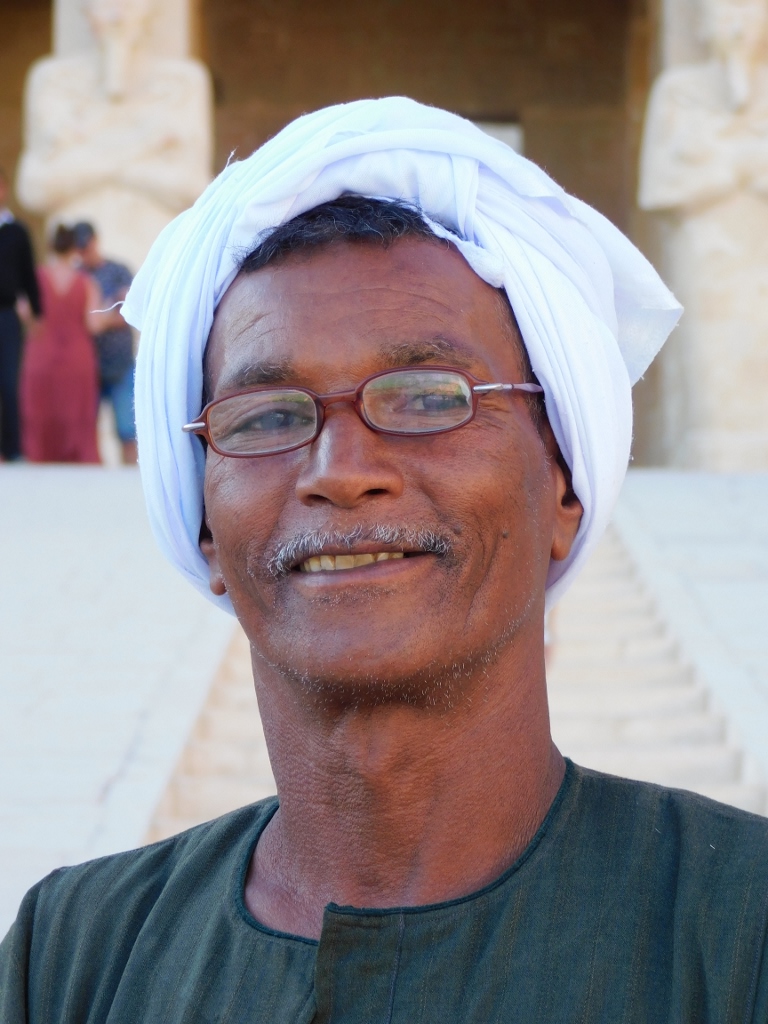 Local guy striking a pose
Local guy striking a pose
On the upper terrace there are again colonnades, but this time in front of some of them you can see the statues of Hatshepsut in the posture of Osiris.
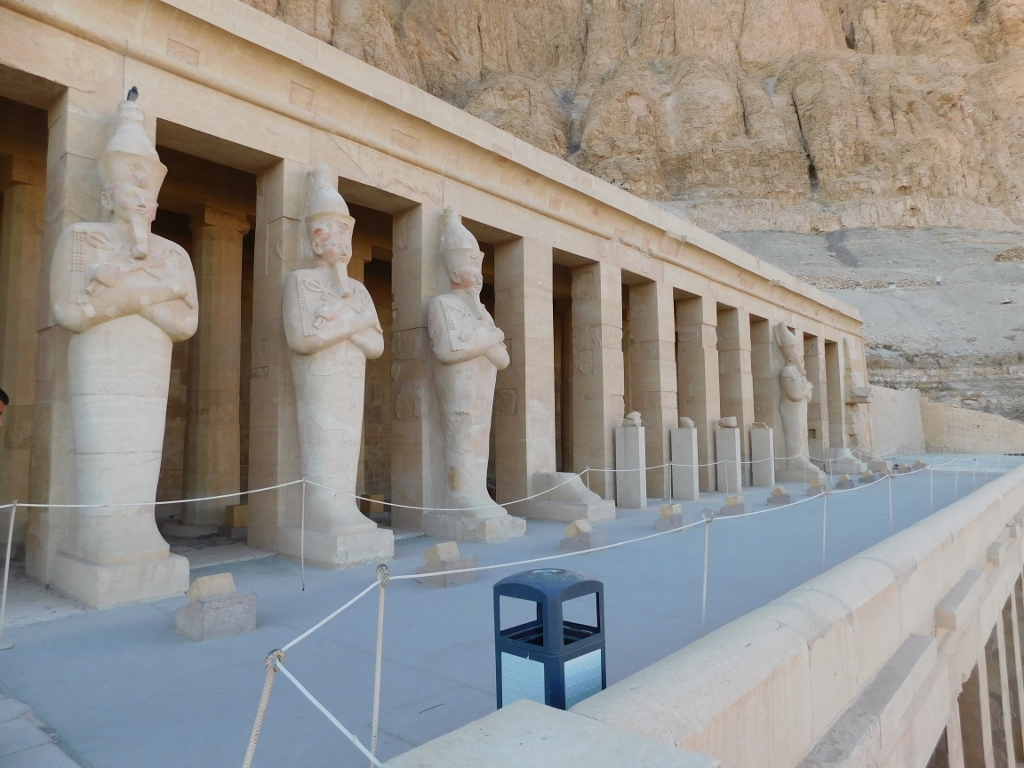 Upper terrace
Upper terrace
When you go through the central gateway from the third terrace within the Temple of Hatshepsut, you pass into the festival courtyard and from there you can enter three shrines.
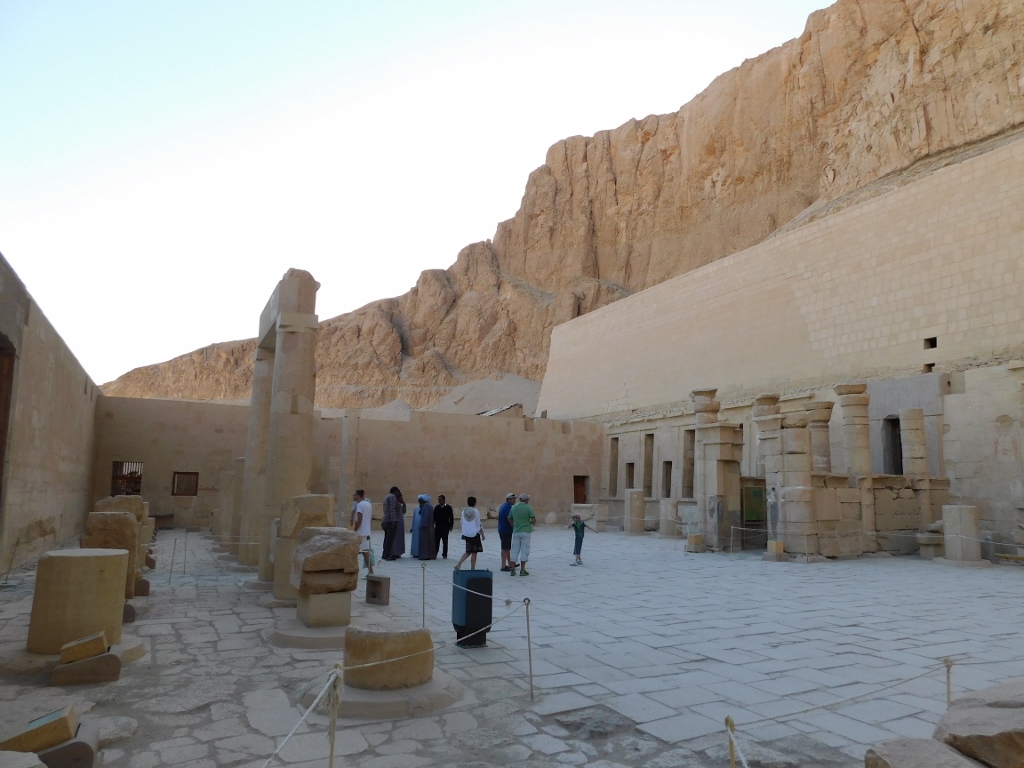 Festival courtyard
Festival courtyard
Straight, there is the main shrine – the Shrine of Amun.
 Temple of Hatshepsut, Shrine of Amun
Temple of Hatshepsut, Shrine of Amun
This is where the celebration of god Amun was at its highest.
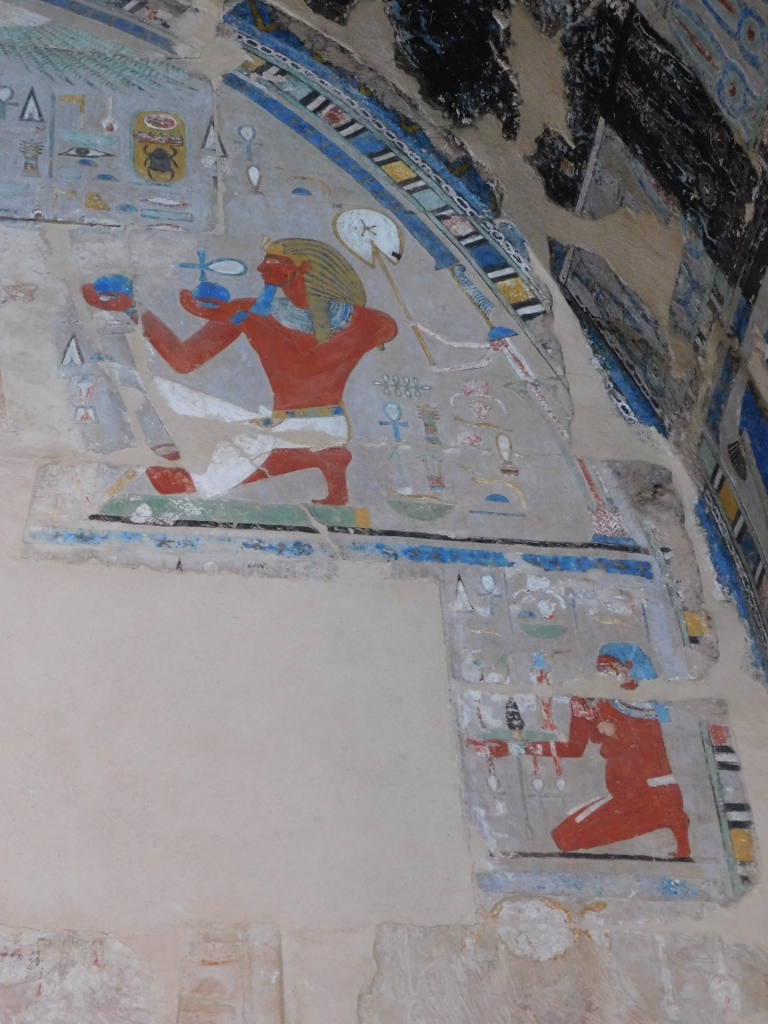 Temple of Hatshepsut, Shrine of Amun, a detail
Temple of Hatshepsut, Shrine of Amun, a detail
In addition to the painted sections, there are also parts with reliefs which are no less impressive.
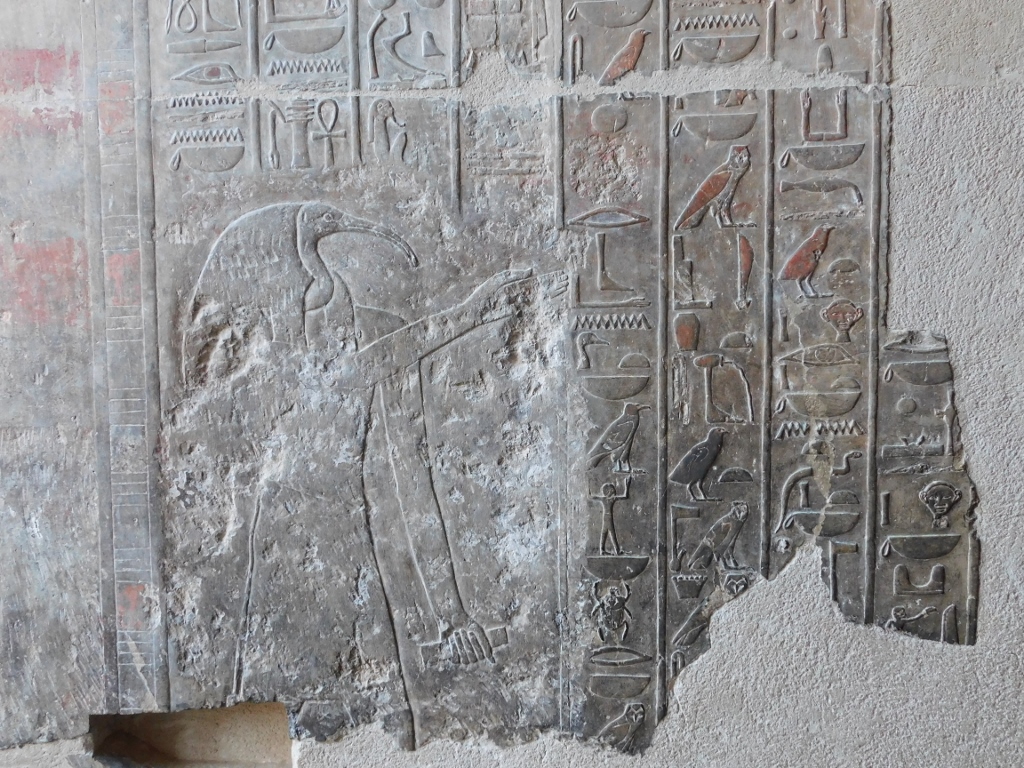 Temple of Hatshepsut, Shrine of Amun, a relief with Thoth
Temple of Hatshepsut, Shrine of Amun, a relief with Thoth
Here I noticed something that I was familiar with from before. This was a restored depiction of god Hapi. God Hapi was the god of the Nile in charge of regular annual fertile floods and he was often depicted in a pair, as a symbol of the link between Upper and Lower Egypt. The unity of these two parts of the kingdom, known also as Two Lands, is shown as a tied papyrus (symbol of Lower Egypt) and lotus (symbol of Upper Egypt). God Hapi was often depicted with female breasts and a large (hanging) belly, thus emphasising the idea of fertility, rich harvest and the power to feed others.
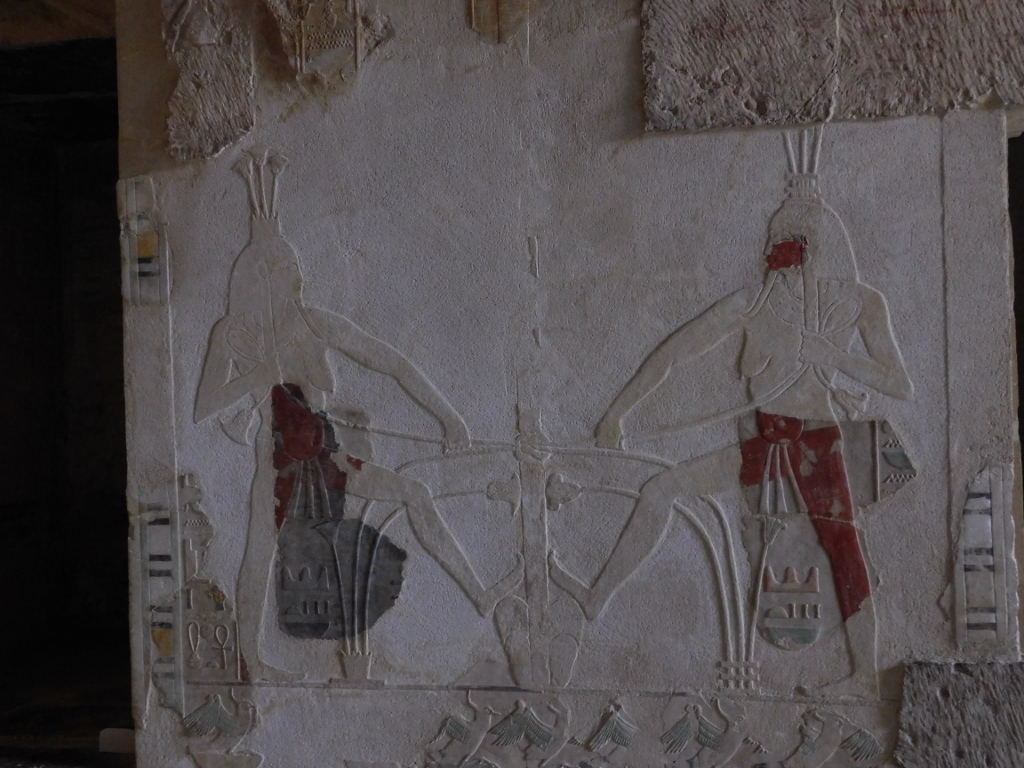 Temple of Hatshepsut, god Hapi in the Shrine of Amun
Temple of Hatshepsut, god Hapi in the Shrine of Amun
From the festival courtyard you can also enter the solar cult court where there is an altar open to the sky.
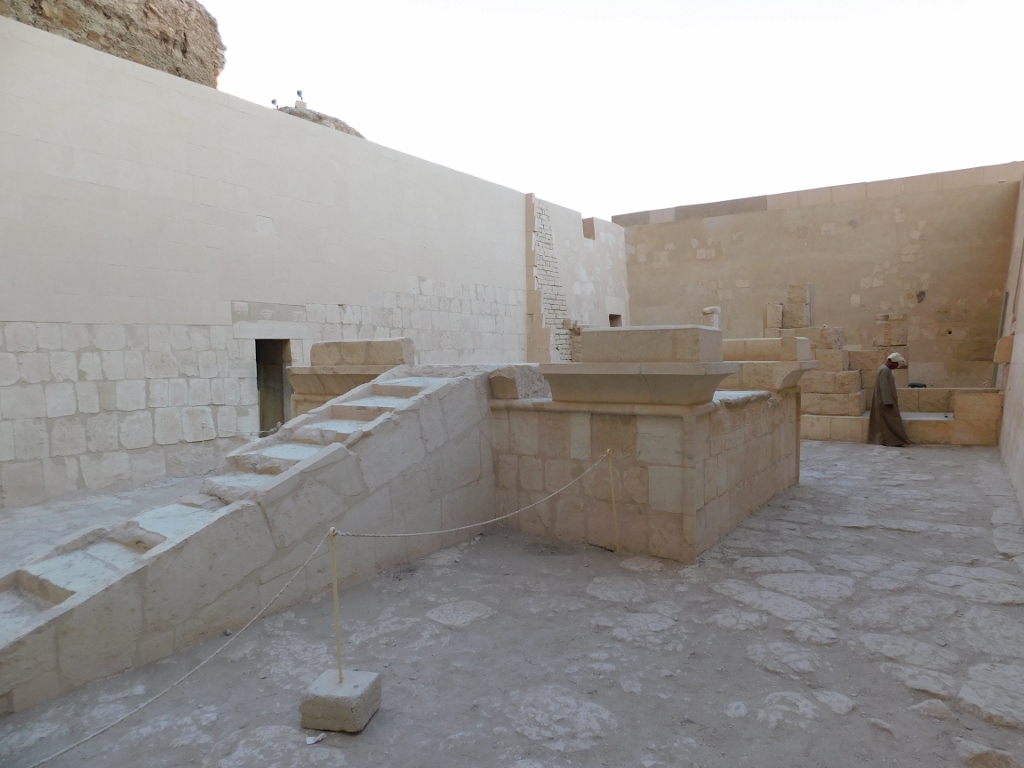 Temple of Hatshepsut, solar cult court
Temple of Hatshepsut, solar cult court
The guard here offered to let me enter one of the niches that are closed off to visits, but I told him I had spent all of my coins and his kindness and wish to show me something extraordinary immediately waned.
Instead, I took a photo of a couple of cartouches and I would dare say that the one on the right-hand side exhibits the name of Pharaoh Thutmose I.
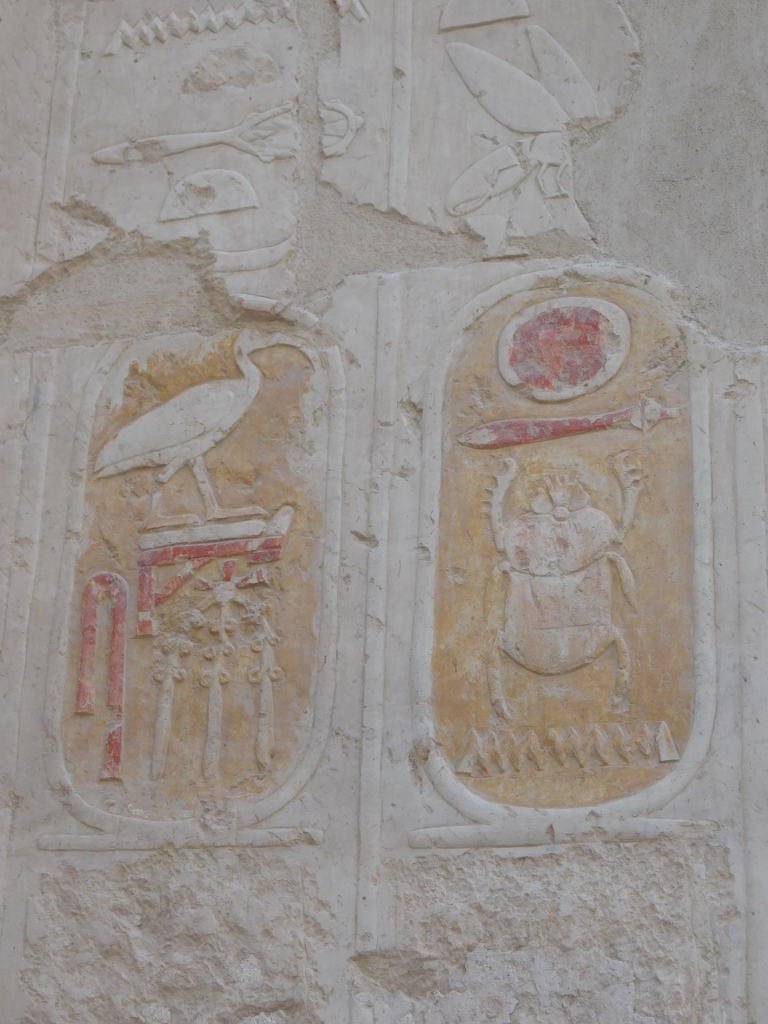 Temple of Hatshepsut, cartouches on a wall at the solar cult court
Temple of Hatshepsut, cartouches on a wall at the solar cult court
Now I had to hurry a little, since I knew the group would start to gather up and I still wanted to visit the Shrine of Anubis. This temple is somewhat smaller than its counterpart, the Shrine of Hathor on the opposite side, but it is nicely covered and has 12 pillars.
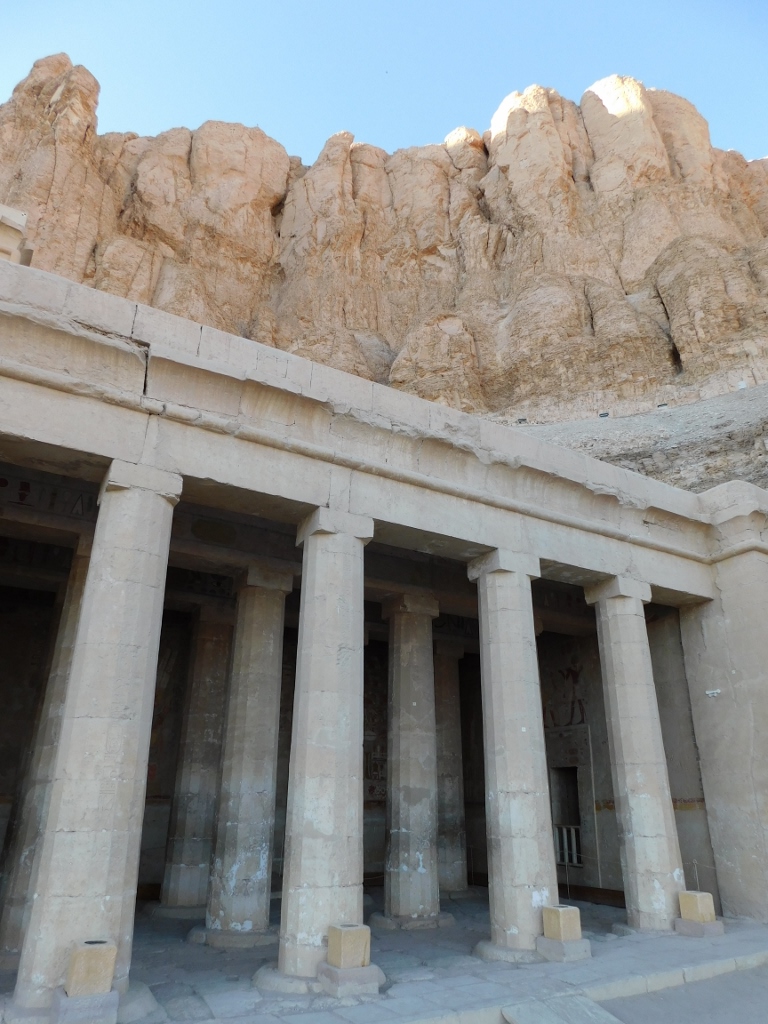 Temple of Hatshepsut, the Shrine of Anubis
Temple of Hatshepsut, the Shrine of Anubis
There are numerous depictions of gods and pharaohs on the walls, mostly showing either the gods themselves or the scenes with offerings brought to them. In any case, I found all of these images magnificent.
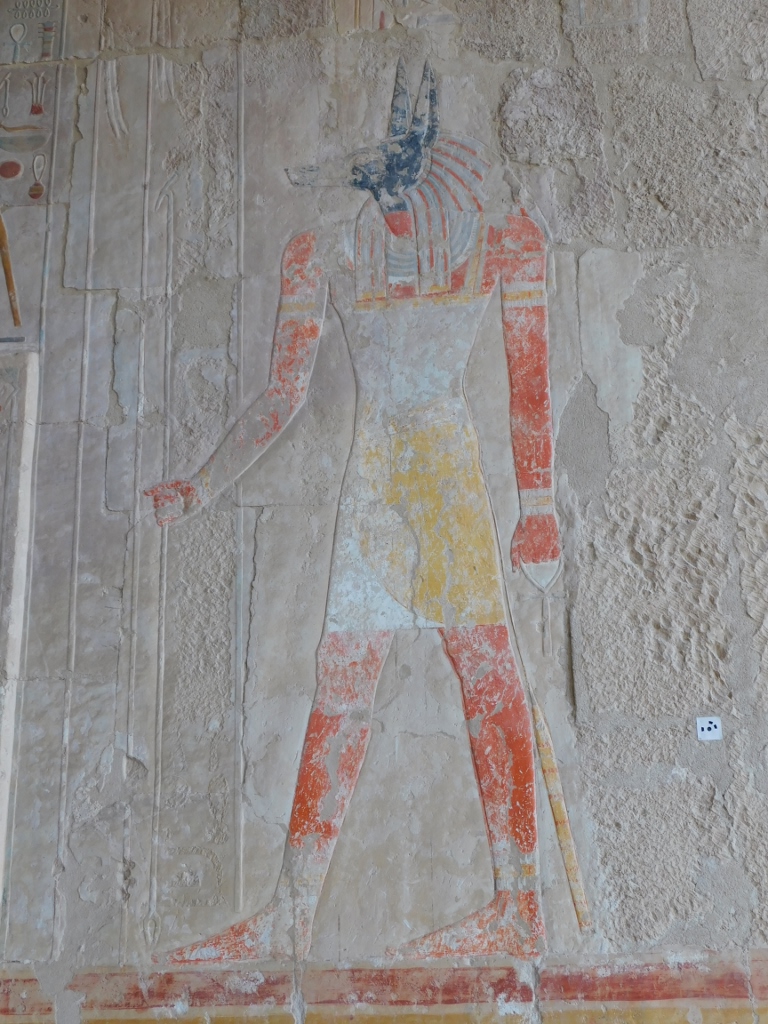 Shrine of Anubis, god Anubis
Shrine of Anubis, god Anubis
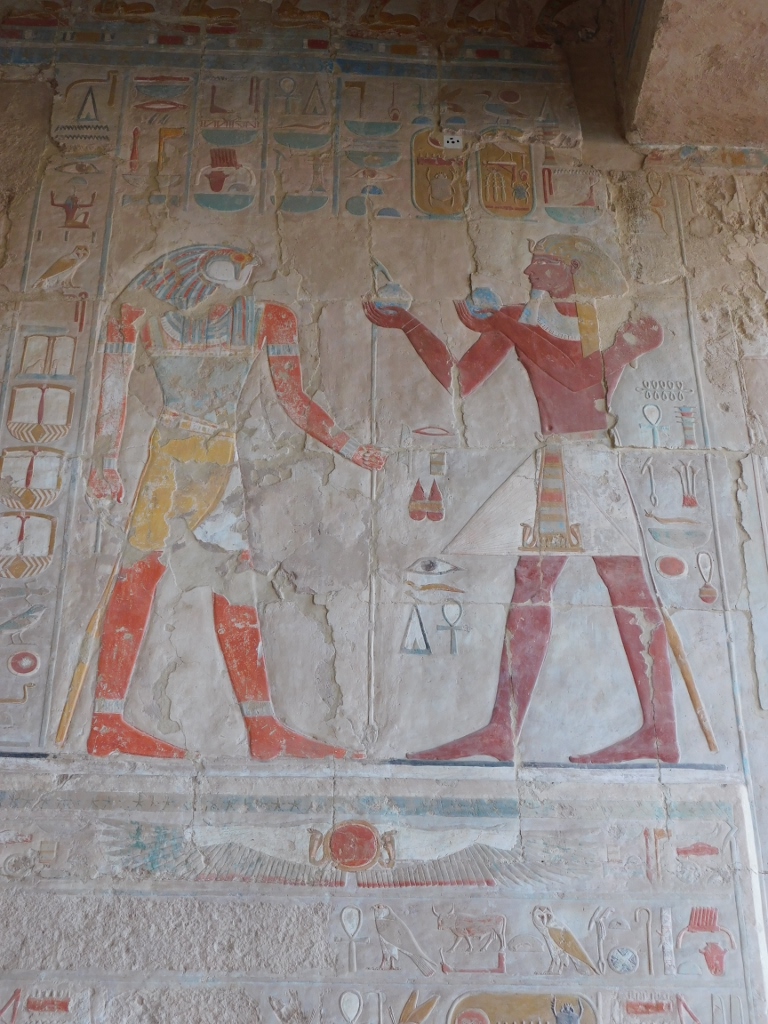 Shrine of Anubis, god Sokaris receives gifts from Pharaoh Thutmose III
Shrine of Anubis, god Sokaris receives gifts from Pharaoh Thutmose III
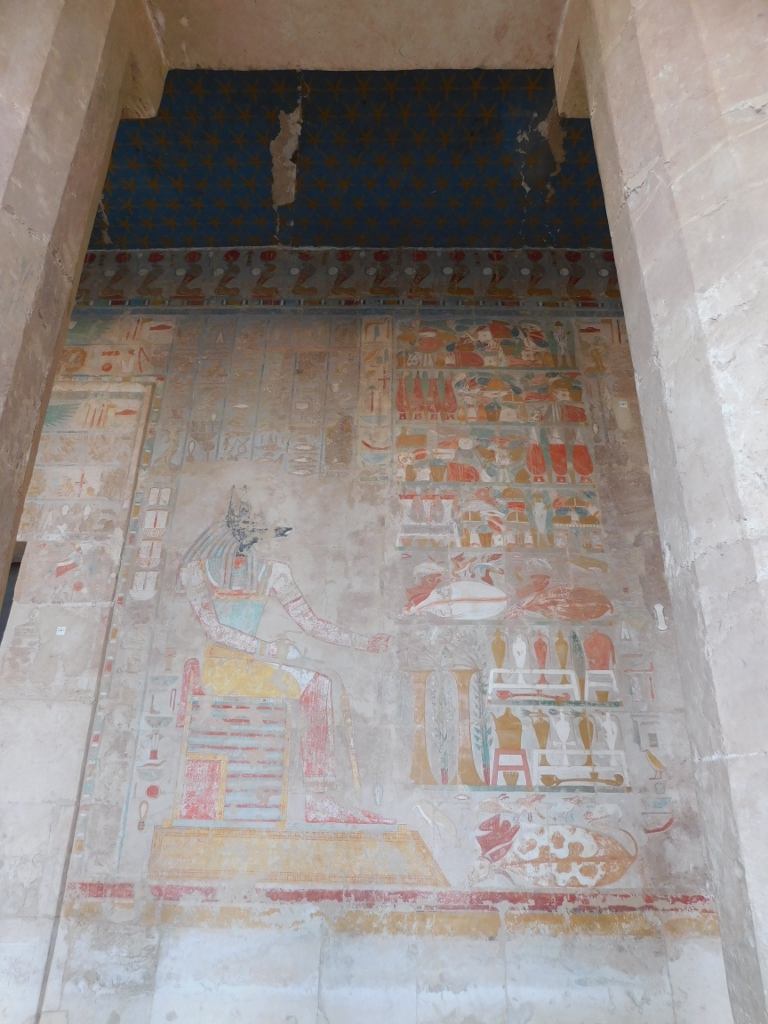 Shrine of Anubis, god Anubis receiving gifts
Shrine of Anubis, god Anubis receiving gifts
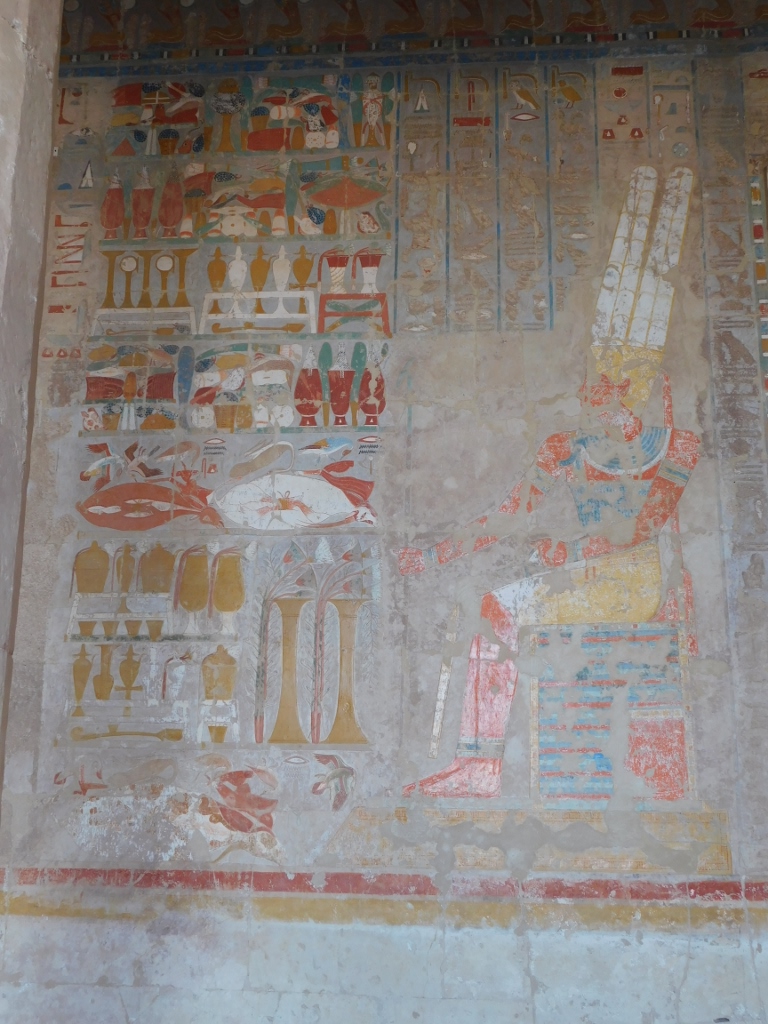 Shrine of Anubis, god Amun receiving gifts
Shrine of Anubis, god Amun receiving gifts
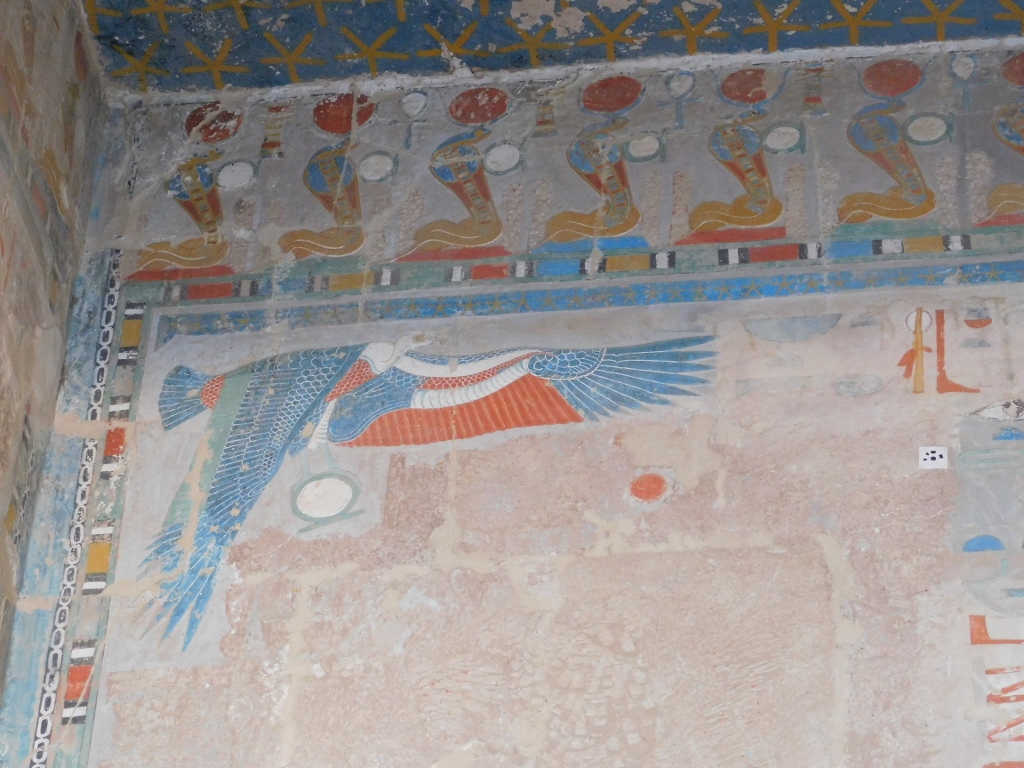 Shrine of Anubis, goddess Nekhbet
Shrine of Anubis, goddess Nekhbet
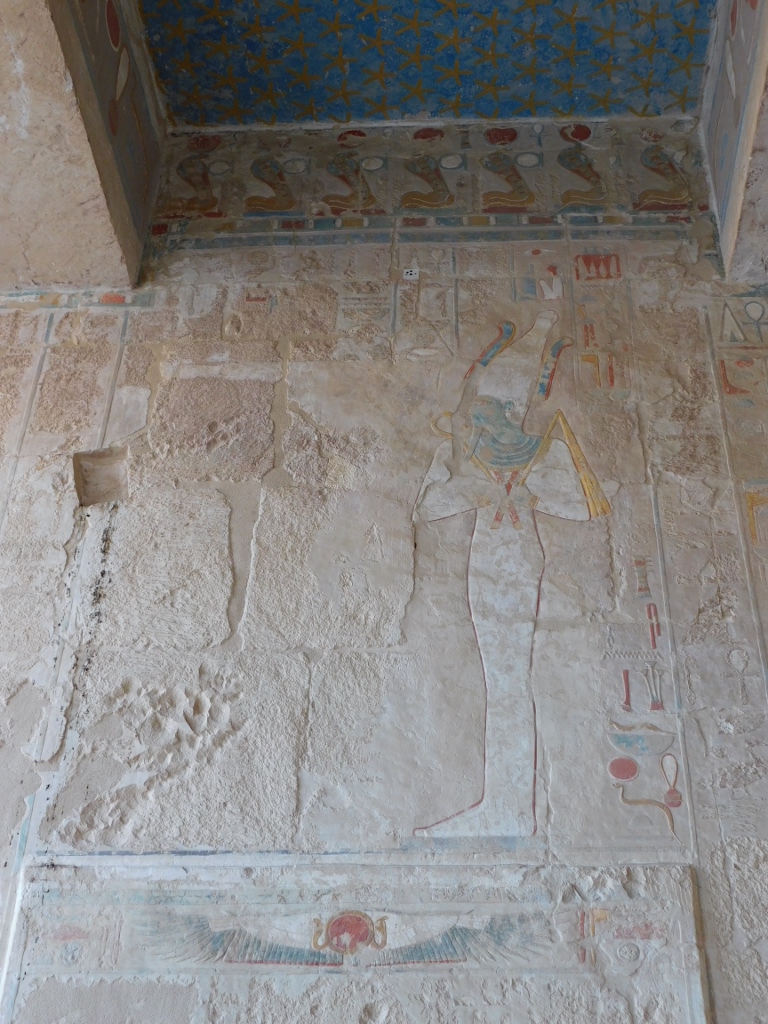 Shrine of Anubis, god Osiris
Shrine of Anubis, god Osiris
And so, here I finished with my visit to the Temple of Hatshepsut.